Star Trek : Stardate Calculator
Tool will convert standard dates to stardates and vice versa.
- access_time Stardate Calculator Date YYYY/MM/DD HH:MM Calculate Stardate:
- date_range Date Calculator Stardate Calculate Date:

Calculate the Fiction Stardate of the Future!
StreamZones.com
FineTunedUniverse.com (Evolution = Millions Of Years + Your Imagination)
GooToYou.com
ExactWeather.com
Back To AnyCalculator.com
Twenty-fourth Century Stardates
Calculating calendar dates in the next generation, deep space nine, and voyager.
While there have been very few references to actual dates in more than 700 episodes of Star Trek , it is possible to derive a fairly accurate correlation between the fictional Stardate system and calendar dates in The Next Generation , Deep Space Nine , and Voyager , based on facts from actual episodes and some calendar math . Facts: Fact: The Next Generation episode "The Neutral Zone," with a Stardate of 41986.0, gave the calendar year as 2364 at the end of the first season . Fact: The Next Generation episode "Data's Day" took place during the Hindu Festival of Lights . The episode aired the week of January 9, 1991 (two and a half years after "The Neutral Zone"), with a Stardate of 44390.1. Fact: Diwali , the five-day Festival of Lights, starts on the New Moon ending the month of Asvina on the Hindu calendar, which typically is the date of the New Moon in India nearest to Halloween. Fact: According to the Calendar Mine 2.0 perpetual calendar, November 3 is the date of the New Moon and the start of Diwali in the year 2366 on Earth. Therefore, the Hindu Festival of Lights would be celebrated in a five-day period starting on November 3, 2366, and ending on November 7, 2366, so Stardate 44390.1 must be within that date span. Fact: The Next Generation episode "Data's Day" also states that Stardate 44390.1 is the 1,550th day since the U.S.S. Enterprise was commissioned. Fact: In The Next Generation episode "All Good Things..." Picard states that he first met Q seven years before Stardate 47988. Their first meeting was depicted on Stardate 41153.7 in "ENCOUNTER AT FARPOINT." Fact: In the Voyager episode "EYE OF THE NEEDLE," Commander Chakotay states that the current year is 2371, with a Stardate of 48579.4. Fact: The Voyager episode "THE 37's" gave the calendar year as 2371 at the beginning of the second season, with a Stardate of 48975.1. Fact: In the Voyager episode "FUTURE'S END," information downloaded from the U.S.S. Voyager 's computer indicates that the Voyager was launched in the year 2371. The first episode of Voyager , "CARETAKER," took place on Stardate 48315.6. Fact: The date for the Voyager episode "11:59" was given as April 22, 2375. (No Stardate was given in the episode, but episodes airing before and after it had Stardates of 52647 and 52861.274.) Fact: The movie STAR TREK: FIRST CONTACT showed that humans made first contact with Vulcans on April 5, 2063. Fact: In the Voyager episode "HOMESTEAD," the crew is celebrating the 315th anniversary of First Contact Day. The following day, a captain's log is recorded on Stardate 54868.6. Fact: An average Earth year comprises about 365.2422 mean solar days. Calculations: Given the above facts, a consistent Stardate system must incorporate the following dates: Stardate 41986.0 must be in the year 2364 ("The Neutral Zone"). Stardate 44390.1 must be between November 3, 2366, and November 7, 2366 ( "Data's Day" ). Stardate 47988 takes place seven years after Stardate 41153.7 ( "ENCOUNTER AT FARPOINT," "All Good Things..." ). Stardate 48315.6 must be in the year 2371 ( "FUTURE'S END," "CARETAKER" ). Stardate 48579.4 must be in the year 2371 ( "EYE OF THE NEEDLE" ). Stardate 48975.1 must be in the year 2371 ( "THE 37's" ). April 22, 2375, takes place between Stardates 52647 and 52861.274 (assuming the episodes before and after "11:59" were in chronological order). Stardate 54868.6 is the day after First Contact Day, the 315th anniversary of April 5, 2063 ( "HOMESTEAD," ). Since The Next Generation episode "Data's Day" and the Voyager episode "HOMESTEAD" both make references to holidays with known dates, these two episodes can be used to establish a Stardate-to-time ratio. However, "Data's Day" (with a Stardate of 44390.1) could take place any time from November 3, 2366, to November 7, 2366, and it is unclear whether "HOMESTEAD" (with a Stardate 54868.6) takes place in the year 2378 or 2377, so that leaves a window of four possible calendar date spans for a definite span of 10478.5 Stardates. (54868.6 - 44390.1 = 10478.5 Stardates) If "Data's Day" took place on November 3, 2366, and "HOMESTEAD" took place on April 6, 2378, then that would give a span of 4,172 days. If "Data's Day" took place on November 7, 2366, and "HOMESTEAD" took place on April 6, 2378, then that would give a span of 4,168 days. If "Data's Day" took place on November 3, 2366, and "HOMESTEAD" took place on April 6, 2377, then that would give a span of 3,807 days. If "Data's Day" took place on November 7, 2366, and "HOMESTEAD" took place on April 6, 2377, then that would give a span of 3,803 days. Given the four possible date spans above, that leaves four possible Stardate-to-time ratios: 4,172 days = 10478.5 Stardates, giving a ratio of 0.39814859 day per Stardate, (4,172 days / 10478.5 Stardates = 0.39814859 day/Stardate) which gives a ratio of 917.351484 Stardates/year . (365.2422 days per year / 0.39814859 day per Stardate = 917.351484 Stardates/year) 4,168 days = 10478.5 Stardates, giving a ratio of 0.397766856 day per Stardate, (4,168 days / 10478.5 Stardates = 0.397766856 day/Stardate) which gives a ratio of 918.23186 Stardates/year . (365.2422 days per year / 0.397766856 day per Stardate = 918.23186 Stardates/year) 3,807 days = 10478.5 Stardates, giving a ratio of 0.36331536 day per Stardate, (3,807 days / 10478.5 Stardates = 0.36331536 day/Stardate) which gives a ratio of 1005.30349 Stardates/year . (365.2422 days per year / 0.36331536 day per Stardate = 1005.30349 Stardates/year) 3,803 days = 10478.5 Stardates, giving a ratio of 0.362933626 day per Stardate, (3,803 days / 10478.5 Stardates = 0.362933626 day/Stardate) which gives a ratio of 1006.36087 Stardates/year . (365.2422 days per year / 0.362933626 day per Stardate = 1006.36087 Stardates/year) If we apply each of the four possible Stardate ratios above to the known fact of the Voyager 's launch date in 2371, then we get the following results: Using the lowest possible Stardate-to-year ratio, 917.351484 Stardates/year , that would mean that the launch of the Voyager on Stardate 48315.6 ( "CARETAKER" ) would be 6553.0 Stardates before April 6, 2378 ( "HOMESTEAD" ), which had a Stardate of 54868.6, (54868.6 - 48315.6 = 6553.0) which would be 2,609.06771 days before April 6, 2378, (0.39814859 day per Stardate x 6553.0 Stardates = 2,609.06771 days) which would mean that "CARETAKER" took place on February 13, 2371. This fits with the fact that the Voyager was launched in 2371 ( "FUTURE'S END" ). Using the second-lowest possible Stardate-to-year ratio, 918.23186 Stardates/year , that would mean that the launch of the Voyager on Stardate 48315.6 ( "CARETAKER" ) would be 6553.0 Stardates before April 6, 2378 ( "HOMESTEAD" ), which had a Stardate of 54868.6, (54868.6 - 48315.6 = 6553.0) which would be 2,606.56621 days before April 6, 2378, (0.397766856 day per Stardate x 6553.0 Stardates = 2,606.56621 days) which would mean that "CARETAKER" took place on February 16, 2371. This fits with the fact that the Voyager was launched in 2371 ( "FUTURE'S END" ). Using the second-highest possible Stardate-to-year ratio, 1005.30349 Stardates/year , that would mean that the launch of the Voyager on Stardate 48315.6 ( "CARETAKER" ) would be 6553.0 Stardates before April 6, 2377 ( "HOMESTEAD" ), which had a Stardate of 54868.6, (54868.6 - 48315.6 = 6553.0) which would be 2,380.80555 days before April 6, 2377, (0.36331536 day per Stardate x 6553.0 Stardates = 2,380.80555 days) which would mean that "CARETAKER" took place on September 30, 2370. This does not fit with the fact that the Voyager was launched in 2371 ( "FUTURE'S END" ). Using the highest possible Stardate-to-year ratio, 1006.36087 Stardates/year , that would mean that the launch of the Voyager on Stardate 48315.6 ( "CARETAKER" ) would be 6553.0 Stardates before April 6, 2377 ( "HOMESTEAD" ), which had a Stardate of 54868.6, (54868.6 - 48315.6 = 6553.0) which would be 2,378.30405 days before April 6, 2377, (0.362933626 day per Stardate x 6553.0 Stardates = 2,378.30405 days) which would mean that "CARETAKER" took place on October 2, 2370. This does not fit with the fact that the Voyager was launched in 2371 ( "FUTURE'S END" ). Given the above results, we can discard possibilities 3 and 4, since they do not fit with a Voyager launch date of 2371. Since these were the only two options in which the episode "HOMESTEAD" took place in 2377, then we can conclude that "HOMESTEAD" must have taken place in April 2378, the 315th anniversary of first contact with Vulcans on April 5, 2063 ( STAR TREK: FIRST CONTACT ). (2063 + 315 = 2378) Having proven that "HOMESTEAD" must have taken place in April 2378, then that means that the only possible Stardate-to-year ratios are between 917.351484 Stardates/year and 918.23186 Stardates/year . If we apply each of these ratios to the fact that Stardate 48975.1 must be in the year 2371 ( "THE 37's" ), we get the following results: Using the lowest possible Stardate-to-year ratio, 917.351484 Stardates/year , that would mean that "THE 37's" (on Stardate 48975.1) would be 5893.5 Stardates before April 6, 2378 ( "HOMESTEAD" ), which had a Stardate of 54868.6, (54868.6 - 48975.1 = 5893.5) which would be 2,346.48872 days before April 6, 2378, (0.39814859 day per Stardate x 5893.5 Stardates = 2,346.48872 days) which would mean that "THE 37's" took place on November 3, 2371. This fits with the stated year of 2371 in "THE 37's" . Using the highest possible Stardate-to-year ratio, 918.23186 Stardates/year , that would mean that "THE 37's" (on Stardate 48975.1) would be 5893.5 Stardates before April 6, 2378 ( "HOMESTEAD" ), which had a Stardate of 54868.6, (54868.6 - 48975.1 = 5893.5) which would be 2,344.23897 days before April 6, 2378, (0.397766856 day per Stardate x 5893.5 Stardates = 2,344.23897 days) which would mean that "THE 37's" took place on November 5, 2371. This fits with the stated year of 2371 in "THE 37's" . If we apply each of the above ratios to the fact that Stardate 41986.0 must be in the year 2364 ("The Neutral Zone"), we get the following results: Using the lowest possible Stardate-to-year ratio, 917.351484 Stardates/year , that would mean that TNG episode "The Neutral Zone" (on Stardate 41986.0) would be 12882.6 Stardates before April 6, 2378 ( "HOMESTEAD" ), which had a Stardate of 54868.6, (54868.6 - 41986.0 = 12882.6) which would be 5,129.18903 days before April 6, 2378, (0.39814859 day per Stardate x 12882.6 Stardates = 5,129.18903 days) which would mean that "The Neutral Zone" took place on March 21, 2364. This fits with the stated year of 2364 in "The Neutral Zone." Using the highest possible Stardate-to-year ratio, 918.23186 Stardates/year ,that would mean that TNG episode "The Neutral Zone" (on Stardate 41986.0) would be 12882.6 Stardates before April 6, 2378 ( "HOMESTEAD" ), which had a Stardate of 54868.6, (54868.6 - 41986.0 = 12882.6) which would be 5,124.2713 days before April 6, 2378, (0.397766856 day per Stardate x 12882.6 Stardates = 5,124.2713 days) which would mean that "The Neutral Zone" took place on March 26, 2364. This fits with the stated year of 2364 in "The Neutral Zone." Conclusions: Given the above facts and calculations , we can conclude that: The Voyager episode "HOMESTEAD" (Stardate 54868.6) must have taken place on April 6, 2378. The highest possible Stardate-to-year ratio is 918.23186 Stardates per year (or 0.397766856 day to 1.0 Stardate , or 1.0 Stardate to 34,367.0564 seconds ). With the two above conclusions, it is possible to calculate a calendar date for any Stardate given in The Next Generation , Deep Space Nine , and Voyager . Given the date of Voyager episode "HOMESTEAD" (Stardate 54868.6) and a ratio of 918.23186 Stardates per year, it is now possible to calculate the starting point of The Next Generation Stardate system, i.e., Stardate 00000.0. Stardate 00000.0 would be 54868.6 Stardates before April 6, 2378 ( "HOMESTEAD" ), which, given the Stardate-to-year ratio established above, would be 21,824.9105 days before April 6, 2378. (0.397766856 day/Stardate x 54868.6 Stardates = 21,824.9105 days) Subtracting 21,824 days, 1,311 minutes, from April 6, 2378, calculates to Friday, July 5, 2318, around noon. So we can conclude that Stardate 00000.0 started on Friday, July 5, 2318 , around noon (Starfleet Command time).
Twenty-third Century Stardates
Calculating calendar dates in the original series.
During the run of The Original Series , there were few references to dates, nor even to the century in which the series took place. Furthermore, the Stardates used in The Original Series had a different starting point than The Next Generation Stardates, so it is impossible to directly extrapolate dates backwards from The Next Generation . However, there were sufficient references in The Next Generation to retroactively calculate dates in The Original Series , with a few additional Stardate facts from episodes of The Original Series , The Next Generation , and Voyager . Facts: Fact: In The Next Generation episode "Sarek," Captain Picard states that Ambassador Sarek is 202 years old. The episode takes place on Stardate 43917.4, which, according to the above calculations , would take place on Tuesday, May 3, 2366. Thus, for Picard's statement to be true on that date, Sarek would have been born between May 4, 2163 and May 3, 2164. Fact: In The Original Series episode "JOURNEY TO BABEL," Ambassador Sarek states that he is precisely 102.437 Earth years old on Stardate 3842.4. Based on the above range determined for the date of Sarek's birth, "JOURNEY TO BABEL" must have taken place between October 11, 2265, and October 9, 2266. Fact: The American Thanksgiving holiday typically is celebrated on the fourth Thursday of November. Fact: In The Original Series episode "CHARLIE X," the crew of the U.S.S. Enterprise is celebrating Thanksgiving. The given Stardates for this episode were 1533.6 and 1533.7. This is 2308.7 Stardates before Stardate 3842.4 in the episode "JOURNEY TO BABEL," which was determined above to have taken place between October 11, 2265, and October 9, 2266. (3842.4 - 1533.7 = 2308.7 Stardates) Fact: Captain Kirk's monologue in the opening titles of The Original Series established that the crew was on a five-year mission. The earliest Stardate in The Original Series was 1312.4 in "WHERE NO MAN HAS GONE BEFORE," and the latest Stardate was 5943.7 in "ALL OUR YESTERDAYS," a difference of 4631.3 Stardates. (5943.7 - 1312.4 = 4631.3 Stardates) Fact: If episodes of The Animated Series are also considered part of the original five-year mission, then the earliest Stardate was 1254.4 in the animated episode "THE MAGICKS OF MEGAS-TU," and the latest Stardate was 7403.6 in the animated episode "BEM," a difference of 6149.2 Stardates. (7403.6 - 1254.4 = 6149.2 Stardates) Fact: In the Voyager episode "Q2," Icheb states that Kirk completed his historic five-year mission in 2270. Therefore, all episodes of The Original Series must have taken place after January 1, 2265 (assuming it was exactly five years), and before January 1, 2271. Fact: In the episode "DAGGER OF THE MIND," on Stardate 2715.1, Dr. Helen Noel said she met Captain Kirk at the Science Lab Christmas party. Fact: Christmas is traditionally celebrated on December 25, and office Christmas parties are typically celebrated sometime in December. Given the possible date range for the five-year mission established in "Q2," the Christmas party referred to in "DAGGER OF THE MIND" must have taken place between December 2265 and December 2270. Calculations: Thanksgiving in "CHARLIE X" took place before the episode "JOURNEY TO BABEL" -- which, as determined above, took place between October 11, 2265, and October 9, 2266 -- and Thanksgiving in "CHARLIE X" must have taken place after January 1, 2265, given the end date of the five-year mission in "Q2." Therefore, the only possible date for "CHARLIE X" would be November 23, 2265 (which is the fourth Thursday of the month, according to the perpetual calendar ). If the Christmas party referred to in "DAGGER OF THE MIND" is assumed to be the same year as Thanksgiving in "CHARLIE X," then there would be at least a month between the two episodes, a difference of 1181.4 Stardates (giving a ratio of less than 1,000 Stardates per month). If the Christmas party were the following year, then the difference of 1181.4 Stardates would span at least a year (which would give a ratio of at least 1,000 Stardates per year). The Christmas party referred to could not be from the year before Thanksgiving in "CHARLIE X," since the possible date range for the five-year mission established in "Q2" dictates that the five-year mission did not begin before 2265. Having calculated above that Stardate 1533.7 is on November 23, 2265 ( "CHARLIE X," ), and that Stardate 3842.4 ( "JOURNEY TO BABEL" ) must be between October 11, 2265, and October 9, 2266, the maximum span between Stardates 1533.7 and 3842.4 (a difference of 2308.7 Stardates) can be no more than 320 days (or 0.876130962 year). Therefore, there must be at least 2635.10833 Stardates per year (or at least 7.21468749 Stardates per day). (2308.7 Stardates / 0.876130962 year = 2635.10833 Stardates/year) This means that Stardate 0000.0 -- 1533.7 Stardates before November 23, 2265, in "CHARLIE X" -- must have started 0.582025408 year (212.58024 days) before that episode. (1533.7 Stardates / 2635.10833 Stardates/year = 0.582025408 year) So, assuming the lowest possible Stardate-to-year ratio of 2635.10833 Stardates per year, Stardate 0000.0 began on Tuesday, April 25, 2265, at 00:00 hours. (November 23, 2265 - 212.58024 days = April 25, 2265) Conclusions: Given the above facts and calculations , we can conclude that: Stardate 0000.0 began on Tuesday, April 25, 2265, at 00:00 hours. The lowest possible Stardate-to-year ratio is 2635.10833 Stardates per year (at least 7.21468749 Stardates per day , or less than 0.138606142 day per Stardate ). Therefore, in The Original Series , one Stardate is no more than 11,975,570.7 milliseconds (0.138606142 day = 11,975,570.7 milliseconds) Given the above starting point and the assumed ratio of 2635.10833 Stardates per year, it is possible to calculate the calendar date for any episode in The Original Series . For example, "DAGGER OF THE MIND," on Stardate 2715.1, would have taken place on May 6, 2266, just a few months after the Christmas party referred to in the episode. So the earliest Stardate in The Original Series -- 1312.4 in "WHERE NO MAN HAS GONE BEFORE" -- took place on October 23, 2265, and the latest Stardate -- 5943.7 in "ALL OUR YESTERDAYS" -- was on July 27, 2267. (The earliest Stardate in The Animated Series -- 1254.4 in "THE MAGICKS OF MEGAS-TU" -- would have taken place on October 15, 2265, and the latest Stardate -- 7403.6 in "BEM" -- would have taken place on February 15, 2268.)
Late Twenty-third Century Stardates
Calculating calendar dates in the movie series.
The first six Star Trek motion pictures continued the pattern of four-digit Stardates from The Original Series . However, it is clear that it is not a simple linear continuation of the same Stardate system. Therefore, either the time ratio of The Original Series Stardates changed mid-way through the original five-year mission and continued through the movies, or else the motion pictures use another Stardate system with a completely new starting point and different time ratio from The Original Series Stardates. Facts: Fact: In STAR TREK: THE MOTION PICTURE , on Stardate 7410.2, Admiral James Kirk has been Chief of Starfleet Operations for the past two and a half years, and hasn't logged a single star hour in that time, since completing his five-year mission. So, based on the end date of the five-year mission established in "Q2," Stardate 7410.2 must be at least two and a half years after January 1, 2270. Fact: Since STAR TREK: THE MOTION PICTURE , on Stardate 7410.2, takes place two and a half years after Captain Kirk's original five-year mission ended, then it must be at least two and a half years after the latest Stardate in The Original Series -- 5943.7 in "ALL OUR YESTERDAYS" -- a difference of 1466.5 Stardates. (7410.2 - 5943.7 = 1466.5 Stardates) Fact: If episodes of The Animated Series are also considered part of the original five-year mission, then STAR TREK: THE MOTION PICTURE , on Stardate 7410.2, must take place at least two and a half years after the latest Stardate -- 7403.6 in the animated episode "BEM" -- a difference of 0006.6 Stardates. (7410.2 - 7403.6 = 0006.6 Stardates) Fact: In STAR TREK: THE MOTION PICTURE , on Stardate 7410.2, V'ger is less than three days away from Earth. On Stardate 7414.1, V'ger reaches Earth, so a span of 0003.9 Stardates must be less than three days. (7414.1 - 7410.2 = 0003.9 Stardates) Fact: In STAR TREK II: THE WRATH OF KHAN , the Project Genesis video proposal was recorded by Dr. Carol Marcus on Stardate 7130.4. After Stardate 8130.4, Admiral Kirk states that the tape was made "about a year ago." Fact: In STAR TREK II: THE WRATH OF KHAN , on Stardate 8130.4, Khan has been stranded on Ceti Alpha Five for 15 years, since Stardate 3143.3 in the episode "SPACE SEED" -- which, according to The Original Series Stardate calculations above, would have taken place on July 4, 2266. Therefore, Stardate 8130.4 must take place after July 4, 2281 (assuming Khan is talking about Earth years and not Ceti Alpha Five years). Fact: In STAR TREK II: THE WRATH OF KHAN , on Stardate 8130.3, Dr. McCoy gives Admiral Kirk a bottle of Romulan Ale (vintage 2283) for his birthday. Therefore, Stardate 8130.3 must take place after 2283 (assuming 2283 is an Earth year, and not a Romulan year or a Stardate). Fact: In STAR TREK III: THE SEARCH FOR SPOCK , around Stardate 8210.3, Starfleet Commander Morrow states that the U.S.S. Enterprise is twenty years old. An officer later refers to Uhura as a twenty-year space veteran. Fact: In STAR TREK III: THE SEARCH FOR SPOCK , the U.S.S. Enterprise flight recorder shows that Spock was dying from radiation poisoning after escaping the Genesis Device detonation on Stardate 8128.78. On Stardate 8128.77, Spock had just been exposed to radiation. Stardates 8128.76.00 to 8128.76.32 spanned a few seconds in which Spock performed a mind-meld with Dr. McCoy before entering the irradiated Engineering chamber. Fact: In STAR TREK IV: THE VOYAGE HOME , on Stardate 8390, the U.S.S. Enterprise crew has been on Vulcan for three months (since just after Stardate 8210.3 in STAR TREK III: THE SEARCH FOR SPOCK ). Therefore, a span of 179.7 Stardates represents at least three months (8390 - 8210.3 = 179.7 Stardates) , so 718.8 Stardates would span at least 12 months (179.7 Stardates/3 months x 4/4 = 718.8 Stardates/12 months) . Fact: In STAR TREK V: THE FINAL FRONTIER , on Stardate 8454.1, the U.S.S. Enterprise NCC-1701-A has been under repairs for at least three weeks. The starship was first seen sometime after Stardate 8390 in STAR TREK IV: THE VOYAGE HOME , so there must be at least a month in the span of 64.1 Stardates (8454.1 - 8390 = 64.1 Stardates) ; therefore, there must be at least a year in a span of 769.2 Stardates (64.1 Stardates x 12 = 769.2 Stardates) . Fact: In STAR TREK VI: The Undiscovered Country , on Stardate 9521.6, the U.S.S. Excelsior detected the destruction of the Klingon moon Praxis, three years after Captain Sulu took command. Two months later, Starfleet Command sends the U.S.S. Enterprise on a diplomatic mission, and Captain Kirk records a log entry on Stardate 9522.6. A few days later, Captain Kirk records his final log entry on Stardate 9529.1. Therefore, a span of 1.0 Stardate is at least two months. (9522.6 - 9521.6 = 1.0 Stardate) . Fact: In STAR TREK VI: The Undiscovered Country , after Stardate 9522.6, McCoy states that he has been ship's surgeon aboard the U.S.S. Enterprise for 27 years. Fact: In the Voyager episode "FLASHBACK," after Stardate 50126.4, Tuvok states that his first deep space assignment aboard the U.S.S. Excelsior , on Stardate 9521, was approximately 80 years ago, when he was 29 years old. Given the assumed date of Tuvok's birth on October 14, 2266, then Stardate 9521 must be at least 29 years after October 14, 2266. However, this conflicts with McCoy's statement that he has been aboard the U.S.S. Enterprise for only 27 years, since his earliest appearance, on Stardate 1512.2 in "THE CORBOMITE MANEUVER," was almost a year before Tuvok's birth .
Star Trek XI-XII Stardates
Calculating calendar dates in the latest movie.
Fact: In STAR TREK , on Stardate 2258.42, Ambassador Spock states that Stardate 2387 is about 129 years in the future, and Stardate 2233.04 is about 25 years in the past. (2387 - 2258.42 = 128.58 Stardates) , (2258.42 - 2233.04 = 25.38 Stardates) . Fact: An average Earth year comprises about 365.2422 mean solar days. Therefore, each 100th of a year would be 3.652422 days. (1 year / 100 = 365.2422 days / 100 = 3.652422 days) . Fact: In STAR TREK INTO DARKNESS , Stardate 2259.55 is approximately one year later than the events in the previous movie (whose Stardate was 2258.42). . Conclusion: The new STAR TREK film appears to use a ratio of one Stardate per year; more specifically, the Stardates in the film are consistent with the actual Earth calendar years expressed with two decimal places (presumably representing hundredths of the calendar year). These new Stardates are used to express calendar dates both before The Original Series Stardates and after The Next Generation Stardates . Using this information, and the above TNG Stardate Calculator and TOS Stardate Calculator , these new Stardates can be compared with calendar dates from both The Original Series and The Next Generation . For example, Ambassador Spock's given Stardate of 2387 in STAR TREK would take place about eight years after the latest known TNG Stardate in STAR TREK: NEMESIS , whose given Stardate of 56844.9 would be around March 29, 2379, according to the above TNG Stardate Calculator . Also, the given Stardate of 2258.42 in STAR TREK , when James Kirk is around 25 years old, would take place about seven years before the earliest Stardate in The Original Series , 1312.4 in "WHERE NO MAN HAS GONE BEFORE," which would be around October 24, 2265, according to the above TOS Stardate Calculator . Kirk's birth on Stardate 2233.04 depicted in STAR TREK would be around January 15, 2233 , assuming Stardate 2233.00 corresponds with 00:00 hours on January 1, 2233. (00:00 January 1, 2233 + 0.04 x 365.2422 days = 00:00 January 1, 2233 + 14.609688 days) . Given Kirk's birth date of January 15, 2233 (assuming his birth date in the alternate universe depicted in STAR TREK was the same as, or close to, his birth date in The Original Series ), his exact age can now be calculated for any Stardate given in an episode of The Original Series . In addition, in STAR TREK II: THE WRATH OF KHAN , Admiral Kirk is celebrating his birthday on Stardate 8130.3 when Dr. McCoy gives him a bottle of Romulan Ale (vintage 2283). Therefore, Stardate 8130.3 (in The Movie Series Stardate system ) must take place around January 15 in some year after 2283 (or a few weeks after January 15, if it is assumed that the alternate events depicted in STAR TREK caused Kirk to be born prematurely).
Date inconsistencies in episodes
While the episodes and assumptions cited above present a fairly accurate and consistent theory for calculating Stardates, there are many other date references -- mostly vague references to years -- that conflict with that theory, though these exceptions do not clearly establish a more-consistent alternative theory, so they may be regarded as errors. Stardate-to-year ratios: In The Original Series episode "THE CORBOMITE MANEUVER" , the span between Stardate 1512.2 and Stardate 1513.8 is described as "18 hours." That is a difference of 1.6 Stardate units (1513.8 - 1512.2 = 1.6 Stardates) . If 1.6 Stardates are 18 hours, then 1 Stardate would equal 11.25 hours (18 hours / 1.6 Stardates = 11.25 hours/Stardate) , and 2.13333333333 Stardates would be one day (24 hours/day / 11.25 hours/Stardate = 2.13333333333 Stardates/day) , so 779.18336 Stardates would be about a year (2.13333333333 Stardates/day x 365.2422 days/year = 779.18336 Stardates/year) . Given the above calculations that there must be at least 2635.10833 Stardates per year (or at least 7.21468749 Stardates per day), the Stardates and hours stated in "THE CORBOMITE MANEUVER" are inconsistent with the overall progression of Stardates in The Original Series . In The Original Series episode "THE GAMESTERS OF TRISKELION" , the span between Stardate 3211.8 and Stardate 3259.2 is described as "nearly two hours." That is a difference of 47.4 Stardate units (3259.2 - 3211.8 = 47.4 Stardates) . If 47.4 Stardates are nearly two hours, then 568.8 Stardates would be nearly a day (47.4 Stardates/2 hours x 24 hours/day = 568.8 Stardates/day ) , and 207,749.76 Stardates would be nearly a year (568.8 Stardates/day x 365.2422 days/year = 207749.76 Stardates/year) . This is inconsistent with the slow progression of four-digit Stardates throughout The Original Series , demonstrating that Stardate spans shown within single episodes cannot be extrapolated to measure Stardates across multiple episodes. In The Next Generation episode " Pen Pals ," the Enterprise enters the Selcundi Drema Sector on Stardate 42695.3. On Stardate 42696.3, Lieutenant Commander Data picks up an alien radio signal. On Stardate 42737.3, Captain Picard states that it has been six weeks since the Enterprise entered the Selcundi Drema Sector. Shortly before Stardate 42741.3, Data says he picked up the alien transmission eight weeks ago. So there is a span of 42.0 Stardates in six weeks (42737.3 - 42695.3 = 42.0 Stardates) , for a ratio of about 7.0 Stardates per week, and a span of 45.0 Stardates in at least eight weeks (42741.3 - 42696.3 = 45.0 Stardates) , for a ratio of 5.625 Stardates per week. These ratios would extrapolate to about 1 Stardate per day, or between 292 and 365 Stardates per year . In The Next Generation episode "The Best of Both Worlds" Part II ," the battle between Starfleet and the Borg at Wolf 359 starts after Stardate 44001.4. and shortly before Stardate 44002.3. In the Deep Space Nine episode "EMISSARY," it was stated that Captain Picard was kidnapped by the Borg on Stardate 43997 for six days, during which he led an assault on Starfleet at Wolf 359, resulting in the death of Jennifer Sisko. Three years later, on Stardate 46379.1, Commander Sisko is reassigned to station Deep Space Nine in orbit of Bajor. So there is a span of about 2376.8 Stardates in three years (46379.1 - 44002.3 = 2376.8 Stardates) , for a ratio of about 792.266666667 Stardates per year (2376.8 Stardates / 3 years = 792.266666667 Stardates/year) . In the Deep Space Nine episode "SECOND SIGHT," on Stardate 47329.4, Commander Sisko records a personal log stating that the previous day was the fourth anniversary of the massacre at Wolf 359 and the death of Jennifer Sisko. So there is a span of about 3327.1 Stardates in four years (47329.4 - 44002.3 = 3327.1 Stardates) , for a ratio of about 831.775 Stardates per year (3327.1 Stardates / 4 years = 831.775 Stardates/year) . (It is unclear whether Sisko is describing Earth years or Bajoran years, since he is on a Bajoran station with 26 hours per day.) In the Voyager episode "RELATIVITY" , Seven of Nine states on Stardate 49123.5621 that the Voyager will be destroyed in three years, six months and two days, on Stardate 52861.274 -- a difference of 3737.7119 Stardates. This is a span of 1,280 to 1,282 days (3.504522888 to 3.509998705 years), depending on leap years and lengths of different months, giving a ratio of around 1,065 Stardates per year . In the Voyager episode "TIMELESS," Captain Janeway states that the Voyager has been in the Delta Quadrant for four years, two months, and 11 days. The following morning, around 08:00 hours, she records a log entry on Stardate 52143.6. In the Voyager episode "CARETAKER," the Voyager was brought to the Delta Quadrant three days before Stardate 48315.6 -- a difference of 3828.0 Stardates before "TIMELESS." Therefore, there is a span of 1,531 days (4.191737923 years) in a span of 3828.0 Stardates, giving a ratio of 913.225 Stardates per year . Between Day 65 and Day 70 of the Voyager episode "YEAR OF HELL," a captain's log was recorded on Stardate 51268.4 (May 5, 2374, according to the above calculations ), and Chakotay later mentions that it is May 20 (Captain Janeway's birthday). In "YEAR OF HELL, PART II," on Day 133 a captain's log is recorded on Stardate 51425.4 (July 6, 2374, according to the above calculations ). Between Day 207 and Day 257, Janeway mentions her birthday was "five months ago;" she later records a captain's log on Stardate 51682.2 (October 16, 2374, according to the above calculations ). On Day 1 after the timeline is restored, a captain's log is recorded on Stardate 51252.3 (April 28, 2374, according to the above calculations ). Therefore, there is a span of 16.1 Stardates in the first 64 days of the "YEAR OF HELL" (51268.4 - 51252.3 = 16.1 Stardates) , giving a ratio of 0.2515625 Stardate per day (16.1 Stardates / 64 days = 0.2515625 Stardate/day) , or 91.88 Stardates per year . The captain's log recorded between Day 207 and Day 257 would be 429.9 Stardates after Day 1 (51682.2 - 51252.3 = 429.9 Stardates) and at least "five months" or 413.8 Stardates after Day 65 (51682.2 - 51268.4 = 413.8 Stardates) . These date spans give a possible ratio of around 700 to 1,000 Stardates per year . The captain's log recorded on Stardate 51425.4 on Day 133 would be 173.1 Stardates after Stardate 51252.3 on Day 1 (51425.4 - 51252.3 = 173.1 Stardates) , giving a span of 173.1 Stardates in 132 days, or a ratio of 1.3113636364 Stardates per day (173.1 Stardates / 132 days = 1.3113636364 Stardates/day) , or 478.96533956 Stardates per year . In The Next Generation episode "The Naked Now," Data first uses his sexual techniques just after Stardate 41209.3 (May 22, 2363, according to the above calculations ). In STAR TREK: FIRST CONTACT , a couple days after Stardate 50893.5 (December 7, 2373, according to the above calculations ), Data states that he last used his programming in sexual techniques eight years, seven months, sixteen days, four minutes, twenty-two seconds ago (which, according to the date calculator , would be a couple days after April 21, 2365, or after Stardate 42973, according to the above calculations ; this would place Data's last use of his programming in sexual techniques between the last two episodes in The Next Generation 's second season ). However, if Data used his programming in sexual techniques only twice -- in "The Naked Now" and STAR TREK: FIRST CONTACT -- then the span of "eight years, seven months, sixteen days, four minutes, twenty-two seconds" (or 272,333,062 seconds) would be a little more than the span between Stardates 41209.3 and 50893.5 (9684.2 Stardates), giving a ratio of less than 9684.2 Stardates per 272,333,062 seconds (or 8.62989831 years), or less than 1122.16849517 Stardates per year . ( 9684.2 Stardates / 8.62989831 years = 1122.16849517 Stardates/year) (50893.5 - 41209.3 = 9684.2 Stardates) . That gives a ratio of more than 1122.5 Stardates per year (9684.2 Stardates / 8.6274 years = 1122.5 Stardates/year) . From and including: Wednesday, April 21, 2365 at 4:52:02 AM To, but not including : Friday, December 7, 2373 at 4:56:24 AM The duration is 3152 days, 0 hours, 4 minutes and 22 seconds Or 8 years, 7 months, 16 days, 4 minutes, 22 seconds Alternative time units 3152 days, 0 hours, 4 minutes and 22 seconds can be converted to one of these units: 272,333,062 seconds 4,538,884 minutes (rounded down) 75,648 hours (rounded down) 450 weeks (rounded down) From date: Friday, December 7, 2373 at 4:56:24 AM Subtracted 8 years, 7 months, 16 days, 4 minutes, 22 seconds Resulting date: Wednesday, April 21, 2365 at 4:52:02 AM (last used) May 22 2363 (first used) --> Given the wild inconsistencies of Stardate ratios in different episodes, some varying by a factor of ten, there can be no conclusive determination of an actual Stardate-to-year ratio for all episodes. Therefore, the ratio of 918.23186 Stardates per year , as calculated above , will remain the basic assumption upon which the above TNG Stardate Calculator is based. Tuvok's Birthday In the Voyager episode "EX POST FACTO," it is stated that Tuvok has been married for 67 years. In the Voyager episode "FLASHBACK," after Stardate 50126.4, Tuvok states that his first deep space assignment aboard the U.S.S. Excelsior , on Stardate 9521, was approximately 80 years ago, when he was 29 years old. In the episode "UNIMATRIX ZERO" PART II , it is stated that Tuvok was born on Vulcanis Lunar Colony on Stardate 38774. This last reference is clearly an error, since Stardate 38774 in The Next Generation system would be just three years before "The Neutral Zone" (41986.0), which gave the year as 2364 -- meaning Tuvok would be just 10 years old in Voyager 's first episode on Stardate 48315.6. It is likely that the decimal was left out of Tuvok's given birth date, and he was really born on Stardate 3877.4 (October 14, 2266, based on the above calculations ) in The Original Series Stardate system. This would place his birth just after The Original Series episode "JOURNEY TO BABEL" , which had a Stardate of 3842.3. Given a birth date of October 14, 2266, Tuvok would be about 106 years old on Stardate 50126.4 in "FLASHBACK," which would be on February 5, 2373, according to the above Stardate Calculator . As stated in "FLASHBACK," Tuvok was 29 years old on Stardate 9521, meaning that STAR TREK VI: The Undiscovered Country must have taken place within the year following October 14, 2295. However, in the episode "FURY," Captain Janeway celebrates Tuvok's birthday, stating it is not long before he reaches "the big three digits." The episode had no Stardate, but the episode before it took place on Stardate 53918, which would place it in the middle of 2377 (based on the above calculations ). If the statement "the big three digits" is taken to mean "100 Earth years," then this would mean that Tuvok would be born after 2277, making him 11 years younger than assumed above. But if "the big three digits" is taken to mean "111 Earth years" (three identical digits), that would be consistent with the above assumptions, since Tuvok would be born on October 14, 2266 (TOS Stardate 3877.4), making him 111 years old on October 14, 2377. This could mean that "FURY," (which had no Stardate) might be shown out of order, and actually took place on Tuvok's 110th birthday, October 14, 2376. (Of course, it is unclear whether Janeway's statement even refers to Earth years rather than Vulcan years, so the statement may not be inconsistent after all, since the duration of a Vulcan year has not been established.) In the Enterprise episode "AWAKENING," Minister Kuvak of the Vulcan High Command states that Earth and Vulcan have been allies for 100 years. The episode takes place in the middle of the year 2154, and apparently refers to first contact between Earth and Vulcans on April 5, 2063, a span of more than 91 Earth years. Since Vulcans are known to quote numbers with great precision, and the statement about 100 years was made between two Vulcans on the planet Vulcan with no humans present, it would be reasonable to assume they were describing the time span in Vulcan years. If so, then 100 Vulcan years is about 91 Earth years, so one Vulcan year would be about 0.91 Earth year. Therefore, Tuvok's age of 111 Earth years would be equivalent to about 121 Vulcan years, making Janeway's statement in "FURY" about him soon reaching "the big three digits" inaccurate in both Earth and Vulcan years.
Screen Rant
Star trek: how stardates are calculated (& what they really mean).
The stardates used in the Star Trek franchise often seem like a jumble of numbers with no real meaning, but there is some method to the madness.
The stardate system used in the Star Trek franchise can sometimes feel like a random selection of numbers, but there is some degree of meaning and calculation involved. When first devising and conceptualizing the futuristic world of Star Trek , Gene Roddenberry decided that the advent of long-range space travel would necessitate a brand new way of measuring time, instead of the standard Gregorian calendar used in the real world. In 1988's Inside Star Trek documentary, original series researcher, Kellam de Forest, revealed that he took inspiration from the 16th century Julian system, which has been implemented by astronomers ever since. Featuring a way of counting days, ignoring leap years and removing the AD and BC system, the Julian method formed the foundation for Star Trek 's stardates.
The inspiration for the stardate system may have been simple enough, but applying it to the scripts proved far more complicated, and the exact correlation between Star Trek time and real-world time has changed throughout the various TV series and movie iterations. For the original Star Trek series , the show's bible instructed writers to pick four numbers and a decimal, with the final digit roughly representing a tenth of a day. The example given is that if noon today was 1313.5, noon tomorrow would be 1314.5.
Related: The Odd-Numbered Star Trek Movie Curse Explained (& Is It True)
However, it's important to note that Roddenberry's initial system of dating was intentionally vague, with pilot episode writer, Samuel A. Peeples, revealing that the stardates weren't designed to be decipherable. Roddenberry was initially reluctant to pin Star Trek down to a specific time, so the stardate increments were uneven from episode to episode. Unfortunately, Star Trek encountered a problem when the series first began to air - the network were showing the episodes out of order. This meant that while the stardates were originally supposed to increase as the series progressed, they actually fluctuated wildly. Roddenberry provided an in-narrative explanation for this phenomenon, claiming that stardates took into account the Enterprise 's speed and position in the galaxy, and therefore were relative to both space and time.
This somewhat clunky system was overhauled for Star Trek: The Next Generation . As well as adding an extra digit, The Next Generation 's writer's guide reveals that a more structured way of calculating stardates was implemented. The first number indicates the century (4 = 24th), the second number represents the season number (1 = season 1) and the following two digits would be largely random and vary with each episode, much like in the original Star Trek series. The fifth digit functioned as a day counter, while, as in Roddenberry's original model, the decimal still represented a tenth of a day. This pattern was retained for both Deep Space Nine and Star Trek: Voyager .
When J. J. Abrams rebooted the Star Trek movie series and splintered into the Kelvin timeline , a brand new dating system was introduced that bore a stronger resemblance to the real-world model. As revealed in the revised Star Trek Encyclopedia , the first two digits would represent century (22 = 23rd century), and the second two digits would calculate the year within that century. The 2009 movie also added more numbers after the decimal point, and these would indicate the day of the year. Therefore, 2235.78 would mean the 78th day of the 35th year of the 23rd century.
Beginning with Star Trek: Discovery , CBS are now in the process of launching a whole new world of content set within the Star Trek universe that will include Star Trek: Picard and a Section 31 spinoff . Looking at the stardates used so far in Star Trek: Discovery , it appears that the franchise will come full circle, returning to the stardate system used in Star Trek: The Original Series . However, with Star Trek: Discovery season 2 ending in the far future, the entire stardate system could become redundant when the show returns.
More: Star Trek: Discovery Makes A Bad Original Series Movie Better
Star Trek: Picard is set to premiere in early 2020 on CBS All Access.
Sources: Inside Star Trek , Gene Roddenberry: The Myth & The Man Behind Star Trek , The Making of Star Trek , Star Trek Encyclopedia
Star Trek Stardate Calculator
About these tools.
These web-based tools can convert between calendar dates and Star Trek Stardates, and are useful for fan fiction writers or role-playing game (RPG) participants.
The calculations are based on prior work by Phillip L. Sublett of TrekGuide.com.
Calendar date to TNG Stardate
Tng stardate to calendar date, calendar date to tos stardate.
coming soon
TOS Stardate to Calendar date

- View history
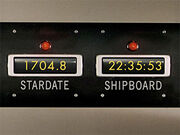
A chronometer in 2266
A stardate was a date in a variety of systems employed by the United Federation of Planets and other societies. It was usually expressed as a number of digits with a decimal separator, e.g. 5928.5 or 2263.02.
- 3.1.1 Gene Roddenberry: The Myth and the Man Behind Star Trek
- 3.1.2 The Star Trek Guide
- 3.1.3 The Making of Star Trek
- 3.1.4 Star Trek 30 Years Special Collector's Edition
- 3.1.5 The Next Generation era
- 3.1.6 Alternate reality
- 3.1.7 Star Trek: Discovery / Star Trek: Strange New Worlds
- 3.1.8 Star Trek: Picard
- 3.1.9 Deviations from production norms
- 3.1.10 Franz Joseph stardates
- 3.2.1 FASA reference stardates
- 3.4 External links
History [ ]
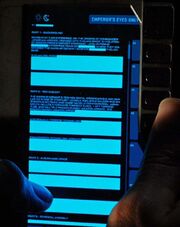
Classified Terran Empire records equated stardate 0141.7 to January 13, 2155
Stardate systems were used in certain cultures as early as the 2150s , when the United Earth government worked with calendar dates. In 2154 , Degra , a Xindi-Primate , sent a coded message to Enterprise NX-01 containing a stardate for when Enterprise should rendezvous with Degra's ship . T'Pol knew that it was three days in the future, indicating that Vulcans also had an understanding of stardates at that time. ( ENT : " Damage ") In the late 2250s, the Terran Empire used them to date events of 2155 . ( DIS : " Vaulting Ambition ")
By 2164 , Starfleet officers would open log entries with a stardate. By 2230 , the first four digits stood for the Gregorian calendar year. In the alternate reality of stardate 2258 , the Jellyfish gave its manufacturing date as "stardate 2387 ". ( Star Trek ) This scheme was used in the alternate reality as late as 2263 . ( Star Trek Beyond ) By 2256 in the prime reality , a more opaque relationship had been established between stardates and the Gregorian calendar. ( DIS : " The Vulcan Hello ") Variations on this scheme were used as late as 3188 . ( DIS : " People of Earth ")
Stardates did not replace clock time or everyday units for expressing larger timespans, such as days, weeks, months, years, centuries, or millennia, and stardate systems tend not to apply retroactively instead of Gregorian or Julian calendars either. ( TOS-R : " The Naked Time ")
Examples [ ]
The following table outlines the progress of stardates over time:
In an alternate timeline that diverged from the prime timeline in 2344 , the term combat date had replaced the term stardate in the dating system used by Starfleet by 2366 . The term was used during the Federation-Klingon War of that timeline . ( TNG : " Yesterday's Enterprise ")
Appendices [ ]
Background information [ ].
Stardates were first portrayed in TOS : " Where No Man Has Gone Before ", the second pilot for the series. Dave Eversole notes that the first draft of the teleplay (dated May 27, 1965) includes "Captain's Log, Report 197." [1] In addition, Star Trek Fact Check shows a scripted narration from the same draft containing "star date 1312.6". This became "star date 1312.4" by the final revised draft (July 8, 1965), which also asks for "C-1277.1 to 1313.7" to appear on Kirk's gravestone. According to Star Trek Fact Check , de Forest Research had this to say about stardates:
(Page 2, Scene 3) But on star date 1312.4 – Astronomers already have adopted a method of dating which makes possible the counting of the number of days elapsed between widely separated observations called 'the Julian Day'. Today July 14, 1965 is 2,438,956 in Julian days. A Julian cycle is 7,980 years, and the Julian day measurement would be scientifically authentic. Suggest "on Julian B 1312.4". This date would be August 5, 3271. (Page 65, Scene 175) C-1277.1 to 1313.7 – We presume dates are in days, Kirk would only be 36 days old. For conventional dating suggest 3235 to 3271. For Kirk's birth date in Julian system figure would be in millions. If desired, can be calculated.
On the other hand, the letter "C" and the rate of increase in the script suggest that 1277.1 was intended to be the date Kirk was promoted to captain and/or assumed command of the Enterprise , not his date of birth. Julian B is meant to be the day count since January 1, 3268, the start of the next 7,980-year Julian Period.
According to Kellam de Forest:
"The original script for the pilot of Star Trek was titled "Menagerie" (sic) and we in the research department, De Forest Research, didn't see it until it was in script form and came to us to review just like any other Desilu script, or any other script from any other client. So we got this script, and the script originally had dates in it, like 2362, and months and days. I felt that that sounded a little awkward for the 23rd, 22nd century, so I thought that there should be another, another dating system. So I checked that, yes, the astronomers had a way of dating called a Julian day system, in which, based on the calculations of a 16th century French mathematician/philosopher that felt that because he devised this calendar with a thousands and thousands of year cycle and each day was numbered, and astronomers have used that since, because it, you don't have to bother with years and leap years and AD and BC. So I suggested to Gene Roddenberry that there was this system out there and the days would be numbered, and he picked up on that and coined the term "stardate" and dated the log and the dating in Star Trek with this stardate system." [2]
Gene Roddenberry: The Myth and the Man Behind Star Trek [ ]
The second pilot was written by Samuel A. Peeples , who was interviewed by journalist Joel Engel for Gene Roddenberry: The Myth and the Man Behind Star Trek . [3] Replying to a newsgroup question on stardates, Engel quoted information from his book:
"For the starship captain's log entry narrations, Roddenberry wanted to devise a futuristic measurement of time reference. He called (Sam) Peeples (whom Roddenberry had contacted early on for help in learning about science fiction, a subject he knew nothing about; it was Peeples who wrote "Where No Man Has Gone Before," the pilot that sold ST). The two men had a few drinks while brainstorming, and soon began chuckling over their imaginative 'stardate' computations. 'We tried to set up a system that would be unidentified unless you knew how we did it,' Peeples says."
"They marked off sections on a pictorial depiction of the known universe and extrapolated how much earth time would elapse when traveling between given points, taking into account that the Enterprise's warp engines would be violating Einstein's theory that nothing could exceed the speed of light. They concluded that the 'time continuum' would therefore vary from place to place, and that earth time may actually be lost in travel. 'So the stardate on Earth would be one thing, but the stardate on Alpha Centauri would be different,' Peeples says. 'We thought this was hilarious, because everyone would say, "How come this date is before that date when this show is after that show?" The answer was because you were in a different sector of the universe.'" [4]
The Star Trek Guide [ ]
The following instructions to writers were copied from the series bible Star Trek Guide; they are quoted at Star Trek Fact Check . [5] The original date of composition and the author are unclear, but the sample stardates are consistent with the range from the second pilot.
"We invented "Stardate" to avoid continually mentioning Star Trek 's century (actually, about two hundred years from now), and getting into arguments about whether this or that would have developed by then. Pick any combination of four numbers plus a percentage point, use it as your story's stardate. For example, 1313.5 is twelve o'clock noon of one day and 1314.5 would be noon of the next day. Each percentage point (sic) is roughly equivalent to one-tenth of one day. The progression of stardates in your script should remain constant but don't worry about whether or not there is a progression from other scripts. Stardates are a mathematical formula which varies depending on location in the galaxy, velocity of travel, and other factors, can vary widely from episode to episode."
What is called a "percentage point" is actually the tenths digit. While the daily rate of increase wasn't always adhered to within episodes, the initial four digits weren't selected quite as randomly as described here. An overall increase with time can be observed in the above table of stardates, from 1312.4 in the second pilot to 5928.5 in the final episode of the series. The Animated Series and the movies continued the general trend, despite a number of variations in the rate of change.
The Making of Star Trek [ ]
Although much of the information from the Star Trek Guide was used in Stephen E. Whitfield 's book The Making of Star Trek (conceived in May 1967 and published in September 1968), the above specifics of selecting stardate numbers weren't included. However, the author did interview Gene Roddenberry on the subject, who provided a more elaborate rationalization for stardate behavior:
"In the beginning, I invented the term "star date" simply to keep from tying ourselves down to 2265 A.D., or should it be 2312 A.D.? I wanted us well into the future but without arguing approximately which century this or that would have been invented or superseded. When we began making episodes, we would use a star date such as 2317 one week, and then a week later when we made the next episode we would move the star date up to 2942, and so on. Unfortunately, however, the episodes are not aired in the same order in which we filmed them. So we began to get complaints from the viewers, asking, 'How come one week the star date is 2891, the next week it's 2337, and then the week after it's 3414?'"
"In answering these questions, I came up with the statement that "this time system adjusts for shifts in relative time which occur due to the vessel's speed and space warp capability. It has little relationship to Earth's time as we know it. One hour aboard the U.S.S. Enterprise at different times may equal as little as three Earth hours. The star dates specified in the log entry must be computed against the speed of the vessel, the space warp, and its position within our galaxy, in order to give a meaningful reading." Therefore star date would be one thing at one point in the galaxy and something else again at another point in the galaxy."
"I'm not quite sure what I meant by that explanation, but a lot of people have indicated it makes sense. If so, I've been lucky again, and I'd just as soon forget the whole thing before I'm asked any further questions about it."
Star Trek 30 Years Special Collector's Edition [ ]
Star Trek 30 Years Special Collector's Edition , published in 1996 by Paramount Pictures , states on page 81:
"Few Star Trek topics generate as much heated debate as the stardate system, the time calculation used by the United Federation of Planets which was introduced to the classic series by Gene Roddenberry, who borrowed the notion from the Julian date currently used by astronomers. Developed by Joseph Justus Scaliger (who named his dating system after his father, Julius Caesar Saliger), the Julian time calculation measures the number of days elapsed since 1 Jan. 4713 BC, the date derived by Joseph Justus. In the case of the 30th anniversary of the air date for the original series (8 Sept. 1996), that's 2,450,335 days. To make it easier, astronomers only use the last five digits – making 50335 the Julian date for the Star Trek anniversary. For Star Trek , Roddenberry added a single digit after the decimal point (50335.2) to represent one of the 10 time measurements in a 24-hour period… Roddenberry borrowed the five-digit Julian date, shortening it to four digits and renaming it "stardate"."
The Next Generation era [ ]
For the series that would come to be known as Star Trek: The Next Generation, Gene Roddenberry was intent on demystifying stardates, joking in his notes of May 14, 1986 that "In the original series, Stardates were determined by a complex formula based on the distance from Earth multiplied by the Producer’s birthday." The revised scheme would simply be a calendar date formatted YYY.MMDD, with the first season set in the year (2)487, the second in (2)488 and so forth, five hundred years into the future. To preserve order, the recommended day and the month would be the date of script assignment, to be replaced in the end by the date of shooting. (In a likely refinement, a typical summer-to-spring sequence of production dates would’ve required seasons to straddle two calendar years: 2487/88, 2488/89...) Anniversaries such as that of the lunar landing on stardate 487.0720 (pronounced "487 point oh-seven twenty") could then be celebrated by the crew. [6]
Ultimately, however, the teleplay of TNG : " Encounter at Farpoint " dated April 13, 1987 was assigned stardates ranging from 42353.7 to 42372.5. ( Star Trek: The Next Generation Companion CD ) This was changed to 41153.7-41174.2 on the air, consistent with the following description in Star Trek: The Next Generation Writer's/Director's Guide of March 23, 1987 (p. 13):
"A stardate is a five-digit number followed by a decimal point and one more digit. Example: "41254.7." The first two digits of the stardate are always "41." The 4 stands for 24th century, the 1 indicates first season. The additional three leading digits will progress unevenly during the course of the season from 000 to 999. The digit following the decimal point is generally regarded as a day counter."
As in TOS, stardates from the first season of TNG would sometimes decrease with time. In one noticeable example Tasha Yar 's death occurs around 41601.3 ( TNG : " Skin Of Evil "), but she was alive in episodes with greater stardates such as " The Big Goodbye ", set around stardate 41997.7.
The second season revision includes more detailed text regarding the decimal place, reiterating The Original Series rule:
"A Stardate is a five-digit number followed by a decimal point and one more digit. Example: "42254.7". The first two digits of the Stardate are always "42." The 4 stands for 24th Century, the 2 indicates second season. The additional three leading digits will progress unevenly during the course of the season from 000 to 999. The digit preceding the decimal point counts days , and the digit following the decimal point counts one-tenth of a day ." [7]
By the sixth season, "consecutively" had replaced "unevenly" from the above quote, consistent with the lack of decreasing stardates in later seasons of TNG.
"A Stardate is a five-digit number followed by a decimal point and one more digit. Example: "46254.7". The first two digits of the Stardate are "46." The 4 stands for the 24th Century, the 6 indicates sixth season. The following three digits will progress consecutively during the course of the season from 000 to 999. The digit following the decimal point counts tenths of a day . Stardate 45254.4, therefore, represents the noon hour on the 254th "day" of the fifth season. Because Stardates in the 24th Century are based on a complex mathematical formula, a precise correlation to Earth-based dating systems is not possible."
In actual fact, these thousand "days" would elapse in roughly a year, as demonstrated by numerous references in dialogue to events from previous seasons. The "century" digit was clarified as early as TNG : " Future Imperfect ", where the imaginary Jean-Luc Riker asks the computer to display his birthday party of stardate 58416, said to be less than sixteen years in the future of 2367. The initial digit may have been inspired by the 24th century, but in-universe it changes once a decade.
The writers of the Star Trek Chronology further developed the system by having a calendar year start at 000 and end at 999, although this does not fit all references in the show, such as a Diwali celebration around stardate 44390, too early in the year according to the simplified system. ( TNG : " Data's Day ") Stardate 41986.0 was in 2364 according to TNG : " The Neutral Zone ", hence the simplified system assumes that stardates 41xxx.x covered the entire year 2364, stardates 42xxx.x the entire year 2365 and so forth. As stated in Star Trek Chronology (p. 95):
"The year 2323 works out as the zero point for the system of stardates developed for Star Trek: The Next Generation , assuming that the beginning of year 2364 (the first season of Star Trek: The Next Generation ) was stardate 41000, and that stardates progress at 1000 units per year. In other words, under the Next Generation system of stardates, January 1, 2323 would seem to correspond to stardate 0. This probably shouldn't be taken too seriously, because Star Trek 's stardates have never been too internally consistent, but we're mentioning it here because it's kinda fun."
The second digit increased every season in TNG spin-offs as well. Since the contemporary DS9 premiered during the sixth season of TNG, stardates on the show ranged from 46379.1 to 52861.3. Likewise, the first season of Voyager (2371) would have paralleled the eighth season of TNG had it continued, so Voyager stardates ranged from 48315.6 to 54973.4. In at least one draft of the script, Star Trek Nemesis had a stardate of 47844.9, but the initial digits were changed to '56' for the film, consistent with Riker having been Picard's "trusted right arm for fifteen years." However, stardates of events prior to TNG : " Encounter at Farpoint ", but not so far back as the time of TOS, do not always conform to this method of counting. According to the Star Trek Chronology :
"Editors' confession: In "Dark Page" (TNG), an entry in Lwaxana's journal dated stardate 30620.1 is established to be during the year in which she got married, 2328. Unfortunately, under the Star Trek: The Next Generation system of stardates (which allocates 1,000 stardate units per year, and puts the beginning of year 2364 at stardate 41000) the beginning of the year 2328 should be around stardate 5000. Star Trek technical consultant (and Chronology co-author) Mike Okuda decided that a four-digit stardate would be confusing since this sounds like an Original Series number, so he arbitrarily picked 30620, even though it is not consistent with stardates used elsewhere in the show."
Okuda noted that in the Star Trek Chronology that there were "ambiguities" inherent in stardate calculation.
In addition to the overall rate of approximately one thousand units per year, many episodes confirm the 24-hour stardate unit mentioned in the series bibles. It is especially noticeable when the time of day is shown next to a stardate fraction, as demonstrated in the table below:
Although the vast majority of stardates are given with only one digit following the decimal point, the captain's log in TNG : " Code of Honor " is recorded with two digits (41235.25 and 41235.32) and other references have two, three, or even four digits, as in TNG : " The Child ", where a stardate of 42073.1435 is seen on a viewscreen in the Observation Lounge . Commenting on the graphic, Mike Okuda explained: " I always thought that the numbers after the decimal were fractions of a 24 hour day, meaning that .1435 would be about 3:20 in the morning. Which is really early in the day for a doctor's appointment... " [8] In VOY : " Relativity ", Seven of Nine travels back in time from 52861.274 to 49123.5621. Occasionally there are no digits, such as when "today's date" is given as stardate 47988. ( TNG : " All Good Things... ")
Alternate reality [ ]
The stardate format from the latest film series is credited to screenwriters Roberto Orci and Alex Kurtzman . According to Orci, they "used the system where, for example, 2233.45 or whatever means 23rd century, 33rd year of that century, and the .45 indicates the day of the year out of 365 days." [9] During a Q&A session, Orci restated that a stardate is "the year, as in 2233, with the month and day expressed as a decimal point from .1 to .365 (as in the 365 days of the year)." [10] He posted a similar reply on Twitter: "star date=standard year, with decimal representing day of year from 1-365." [11]
The new stardates are similar to the ordinal date s of ISO 8601, which would express the first day of 2260 as 2260-001, and the last as 2260-366. Orci hasn't clarified whether leap days increase the count to .366, which would be expected if the years are Gregorian. When asked about 2230.06 and 2233.04 from the Star Trek screenplay, with only one leading zero instead of two or none, he replied that it could have been an error. [12] IDW's Star Trek: Timelines show the latter number as 2233.4, while Star Trek Beyond places Kirk's birthday "a couple of days" after 2263.2 from his log entry. Shortly thereafter, Ambassador Spock's date of death is displayed as 2263.02, and his date of birth again as 2230.06. When Uhura calls for help from Krall's base, her screen shows "226X.XX", which isn't labeled a stardate but does suggest an entire two-digit range. Though farther from the films' production, the Star Trek Encyclopedia sees 2233.04 as January 4 of that year.
The alternate reality adaptation of " Where No Man Has Gone Before " begins with a stardate in the new style, but the second part of that comic reverts to 1313.1, consistent with the range of its prime reality counterpart, and the same approach is taken with " The Galileo Seven " reimagining, which begins on stardate 2821.5. After that story was finished, writer Mike Johnson commented at TrekMovie.com: " Speaking of typos... Going forward we are using the new Stardate system. " [13] Even so, not every alternate stardate may have been chosen correctly for the intended chronological order. According to Johnson in the Open Channels section of " The Q Gambit, Part 4 " (p. 25):
"The ongoing series is running in chronological order, except for those stories that are established as a flashback, like the origin of Science Officer 0718. So "The Q Gambit" takes place after "The Khitomer Conflict" and "Parallel Lives", and after the Enterprise has embarked on its new five-year mission after Star Trek Into Darkness ."
" The Q Gambit " begins on stardate 2261.34, and yet " The Khitomer Conflict " already saw the higher stardates 2261.147, .149 and .168. " Parallel Lives " continued with .274 and .234 in that order. " Live Evil, Part 1 " could not have been set after Star Trek Beyond , where the Enterprise is destroyed. Still, the digits after the separator always fall within Orci's range, even if the comics do not provide the matching days of the month. The table below shows only new-style stardates from the films and other sources, along with their calculated equivalents in the Gregorian calendar. Given the above evidence, the conversion provisionally assumes that .0# was always intended to mean Day #, not a fraction of the year.
As seen in the table, when asked by the alternate Spock , the computer aboard the Jellyfish reports a manufacturing stardate of 2387, consistent with the timespan of 129 years stated earlier in the film. The comic miniseries Star Trek: Countdown , which details events in the prime reality that led to the 2009 film , nevertheless gives its latest stardate as 64467.14, resulting in mid-2387 according to the Chronology rules. Moreover, Star Trek Online , set over twenty years after the destruction of Romulus, continues to use the format created for TNG, placing it in the 86000 range; on the other hand, Star Trek: Timelines freely applies alternate reality stardates to events from the prime reality.
Star Trek: Discovery / Star Trek: Strange New Worlds [ ]
A week before the premiere, the Star Trek Twitter page began counting up from 1200.4, continuing daily with 1201.5, 1202.4, 1203.4, 1204.5, 1205.4, 1206.5, and finally 1207.4, consistent with stardate 1207.3 of the first episode. [14] While this rate of increase matches the convention in TOS, the numbers are higher than 1024.7 for Joran Dax's birth in the following decade. Later episodes establish stardates in the actual TOS range, as well as the familiar changing rates and numbers decreasing with time. Having reached a peak in Season 1 of 4851.5, the initial digit reverts to 1 in Season 2, which ends with stardate 1201.7. Season 3 begins in the far future but preserves stardates as revised on TNG: 865xxx.x for the year 3188, though a number with eight integer digits and a decimal appears in an Emerald Chain document.
Star Trek: Picard [ ]
Writer, executive producer, and first season showrunner on Star Trek: Picard , Michael Chabon , eschewed the use of stardates, stating in an Instagram story dated 26 February 2020:
"Stardates, in my view, and I know this is going to make some people mad, are a uniquely perverse form of uninformative information. Using a stardate tells you precisely nothing. Even people who know how to interpret and convert them have to go off and interpret and convert them to have them mean something. Giving an audience the stardate is like I wanted to know if I needed to put on a sweater or not, and you told me the temperature outside in Kelvin. 'It's 287 out.'" [15]
The first stardate given was 78183.10 in the third season episode, “ No Win Scenario .” The second was 78186.03 in the next episode. In the series finale, " The Last Generation ,” William T. Riker says, “Captain’s log, stardate…shall we say, ‘One?’”
Deviations from production norms [ ]
Stardates would occasionally deviate from the prevailing production norm throughout Star Trek incarnations. Examples include:
- In TOS : " Where No Man Has Gone Before ", the stardates within the episode progress by 1.4, from 1312.4 to 1313.8, in what could not be more than a few days, yet the birthdates of Gary Mitchell and Elizabeth Dehner are given as 1087.7 (onscreen dossier age: 23) and 1089.5 (onscreen dossier age: 21), respectively. However, the numbers aren't explicitly labeled as stardates.
- The animated episode " The Magicks of Megas-Tu " set in 2269 has a stardate of 1254.4. This is lower than in any TOS episode, including the first Kirk-era show, TOS : " Where No Man Has Gone Before ", set in 2265 with a stardate of 1312.4.
- In Star Trek II: The Wrath of Khan , the opening graphic for Project Genesis is given a stardate of 7130.4, which should predate the USS Enterprise refit, yet Captain Kirk commented that the recording was just over a year old around stardate 8130.
- In TNG : " Datalore ", Riker dropped the fifth digit in his log, stating "stardate 4124.5". His entry is missing from the revised final draft of 10/26/87; it is surrounded by stardates 41242.4 and 41242.45, as recorded in Picard's log.
- In VOY : " Unimatrix Zero, Part II ", set during stardate 54014.4, Tuvok mentions that his date of birth is stardate 38774, but he was born in 2264.
- VOY : " Homestead " gives a stardate of 54868.6, which would suggest a date sometime in late 2377, but in fact the episode is set on the 315th anniversary of the first contact with Vulcans, which works out to April 5, 2378.
Franz Joseph stardates [ ]
Aside from those patterned after TOS, the stardates in the Star Fleet Technical Manual were generated using calendar dates of the 1970s, formatted YYMM.DD. This can be inferred by comparing the dates of first printing (November 1975) and of the 20th anniversary edition (September 1986) with the corresponding stardates, 7511.01 and 8609.01, as well as the decimal digits in technical order stardates, which suggest days of months. In addition to being easy to use, such stardates had the advantage of roughly matching in-universe ranges from the original film era. The 1979 Star Trek (Stardate) Calendar also used this format. [16]
Apocrypha [ ]
Fasa reference stardates [ ].
FASA 's Star Trek: The Role Playing Game released in the early 1980s used "reference stardates" ( β ) similar to those used by Franz Joseph. However, they prefixed a digit and a slash to represent the century, starting with the year 2000, so January 1, 2000, was 0/0001.01 and the Organian Peace Treaty was signed on 2/0801.24, or January 24, 2208 ( β ), according to Star Trek Spaceflight Chronology . Preceding centuries are negative, so the first episode of TOS aired -1/6609.08.
In the novel Where Sea Meets Sky , Captain Christopher Pike has to use conversion formulas to convert stardates to the Gregorian Calendar for his friend Nowan from the bar The Captain's Table.
In the Millennium novel The War of the Prophets , the stardate system is based on hyperdimensional distance averaging.
External links [ ]
- Stardate at Memory Beta , the wiki for licensed Star Trek works
- Universal Stardate Converter
- The Stardate FAQ – primarily develops one particular theory of stardates that has gained some currency
- Determining Calendar Dates from Stardates – has calculations and calculators based upon information from the television series' and movies
- Star Trek logs (X) – database of stardates and logs from the Star Trek films and television series
- Calendar conversion at Funaba.org – includes ordinal dates, which are practically identical to the alternate reality stardates
- 3 Ancient humanoid

Stardate Calculator
Stardate to date, date to stardate.
How Do Star Trek Stardates Work?
By chris higgins | sep 20, 2015.
On Star Trek , we hear a lot of "stardates," meant to mark some futuristic date. An example is stardate 47457.1, which is Captain Picard's birthday . The weird thing is that stardate 47457.1 is either the equivalent June 16th, November 4th, January 8th, or January 10th, depending on how you count. Let's go deep-nerd on this.
The Original Series
In the original Trek TV series, stardates were, in a word, bogus. In the series bible, the Star Trek Guide , writers were basically told to wing it. Here's a snippet (emphasis added):
Pick any combination of four numbers plus a percentage point [ed. note: tenths digit], use it as your story's stardate. For example, 1313.5 is twelve o'clock noon of one day and 1314.5 would be noon of the next day. Each percentage point is roughly equivalent to one-tenth of one day. The progression of stardates in your script should remain constant but don't worry about whether or not there is a progression from other scripts. Stardates are a mathematical formula which varies depending on location in the galaxy, velocity of travel, and other factors, can vary widely from episode to episode.
This obviously wasn't thought through very well, as it boils down to "Pick a number and stay near it." Show creator Gene Roddenberry later said:
When we began making episodes, we would use a stardate such as 2317 one week, and then a week later when we made the next episode we would move the star date up to 2942, and so on. Unfortunately, however, the episodes are not aired in the same order in which we filmed them. So we began to get complaints from the viewers, asking, "How come one week the star date is 2891, the next week it's 2337, and then the week after it's 3414?"
He then went on to explain that the whole "location in the galaxy, velocity of travel, and other factors" thing was a hedge to cover up the fact that the dates simply weren't consistent to begin with, even if the episodes had aired in order.
The Next Generation
In Star Trek: The Next Generation , things got a bit more consistent. In the original TNG Writer's/Director's Guide , the show-runners devised a sensible formula with a reasonable level of continuity. Here it is:
A stardate is a five-digit number followed by a decimal point and one more digit. Example: "41254.7." The first two digits of the stardate are always "41." The 4 stands for 24th century, the 1 indicates first season. The additional three leading digits will progress unevenly during the course of the season from 000 to 999. The digit following the decimal point is generally regarded as a day counter.
It's interesting to note, then, that the duration of a TNG season is 1,000 days. Good thing they were on a continuing mission rather than a five-year one.
Both Star Trek: Deep Space 9 and Star Trek: Voyager continued using the TNG style of Stardates, and the movie Star Trek Nemesis followed suit.
As you might expect, early on in TNG , the writers sometimes goofed. A prime example is Tasha Yar's death, which occurred circa Stardate 41601.3, but she was alive in a previous episode with the (later) Stardate 41997.7. Oops. By 1992, the writers had revised their guidelines to be iron-clad:
A Stardate is a five-digit number followed by a decimal point and one more digit. Example: "46254.7". The first two digits of the Stardate are "46." The 4 stands for the 24th Century, the 6 indicates sixth season. The following three digits will progress consecutively during the course of the season from 000 to 999. The digit following the decimal point counts tenths of a day. Stardate 45254.4, therefore, represents the noon hour on the 254th "day" of the fifth season. Because Stardates in the 24th Century are based on a complex mathematical formula, a precise correlation to Earth-based dating systems is not possible.
Despite explicitly stating that correlation to Earth-based dates is not possible, that hasn't stopped people from trying .
Just when things were basically making sense, they changed again. From an exhaustive and brilliant article on Memory Alpha , here's an explanation of the reboot (J.J. Abrams-directed) movies' treatment of stardates (emphasis added):
The stardate format from the latest film series is credited to screenwriters Roberto Orci and Alex Kurtzman. According to Orci, they "used the system where, for example, 2233.45 or whatever means 23rd century, 33rd year of that century, and the .45 indicates the day of the year out of 365 days." During a Q&A session, Orci restated that a stardate is "the year, as in 2233, with the month and day expressed as a decimal point from .1 to .365 (as in the 365 days of the year)." He posted a similar reply on Twitter: "star date=standard year, with decimal representing day of year from 1-365." The new stardates are similar to the ordinal dates of ISO 8601, which express the first day of 2260 as 2260-001, and the last as 2260-366. Orci hasn't clarified whether leap days increase the count to .366, which would be expected if the years are Gregorian. When asked about 2230.06 and 2233.04 from the Star Trek screenplay, with only one leading zero instead of two or none, he replied that it could have been an error. IDW's Star Trek: Timelines show the latter number as 2233.4.
Long Story Short
There is no one answer to how stardates work, aside from saying that they don't. They're inconsistent series-to-series, and even within a given series, the writers often mixed things up. With Roddenberry trying to retcon the system's continuity even in TOS , perhaps it's appropriate that the system continues to be more than a little mixed up. Time-tracking throughout the galaxy is a hard problem; give 'em some slack.
If you're curious about examples of various Stardates (and even more discussion of this issue), check out Memory Alpha 's stardate page . Trust me, once you've read that, you'll never want to speak of this subject again. If you do, read this page for a deeply unofficial (but supremely logical) system of decimal time. Oh, and don't forget the time the French made a 10-hour day —another attempt to create decimal time that led to total confusion.
Calculate the Stardate of the Star Trek Future!
- PRO Courses Guides New Tech Help Pro Expert Videos About wikiHow Pro Upgrade Sign In
- EDIT Edit this Article
- EXPLORE Tech Help Pro About Us Random Article Quizzes Request a New Article Community Dashboard This Or That Game Popular Categories Arts and Entertainment Artwork Books Movies Computers and Electronics Computers Phone Skills Technology Hacks Health Men's Health Mental Health Women's Health Relationships Dating Love Relationship Issues Hobbies and Crafts Crafts Drawing Games Education & Communication Communication Skills Personal Development Studying Personal Care and Style Fashion Hair Care Personal Hygiene Youth Personal Care School Stuff Dating All Categories Arts and Entertainment Finance and Business Home and Garden Relationship Quizzes Cars & Other Vehicles Food and Entertaining Personal Care and Style Sports and Fitness Computers and Electronics Health Pets and Animals Travel Education & Communication Hobbies and Crafts Philosophy and Religion Work World Family Life Holidays and Traditions Relationships Youth
- Browse Articles
- Learn Something New
- Quizzes Hot
- This Or That Game New
- Train Your Brain
- Explore More
- Support wikiHow
- About wikiHow
- Log in / Sign up
- Arts and Entertainment
How to Calculate Stardates
Last Updated: September 23, 2023
wikiHow is a “wiki,” similar to Wikipedia, which means that many of our articles are co-written by multiple authors. To create this article, volunteer authors worked to edit and improve it over time. This article has been viewed 62,042 times. Learn more...
Stardate is the dating system used in Star Trek. In the original series, they just made it up; so long as the next stardate was after the current stardate, it worked. Later on, it got a bit more serious.
Converting from Common Date to Stardate

Converting from Stardate to Common Date

Community Q&A
- When converting stardates back into common dates, you may (not often) be a couple of days out due to rounding errors. Thanks Helpful 0 Not Helpful 0
You Might Also Like

About This Article
- Send fan mail to authors
Did this article help you?

Featured Articles

Trending Articles

Watch Articles

- Terms of Use
- Privacy Policy
- Do Not Sell or Share My Info
- Not Selling Info
wikiHow Tech Help Pro:
Develop the tech skills you need for work and life
- Welcome to Star Trek Online Roleplay . Please log in or sign up .
Welcome to Star Trek Online Roleplay - The Hub for Roleplay within Star Trek Online
- Stardate Calculator

- Star Trek Online Roleplay
- ► Resources
- ► Stardate Calculator
- (February 19, 2024, 02:41:16 AM)
Users Online
Articles in « resources ».
- TinyPortal | Help | Terms and Rules | Go Up ▲
- SMF 2.1.4 © 2023 , Simple Machines , TinyPortal 2.2.2 © 2005-2022 | idesignSMF
Page created in 0.510 seconds with 31 queries.
After nearly 14 years the STO Academy closed its doors. It has provided information and tools to the players of Star Trek Online for as long as the game has existed. Rest assured, the fleet still exists in game for anyone who wishes to get together with other players who want to have fun playing together.
I know some of you are wondering why I decided to shut down the website. There's a number of reasons, all resulting in one realization. I haven't been able to give the website the attention it requires nor will I be able to do so in the near future.
I hope the day comes when I'll be able to bring the STO Academy website back. It was a passion of mine that I truly enjoyed building over the years.
I want to thank everyone who had a hand in shaping the STO Academy, everyone who has ever used the website, and everyone who supported me.
Live long and prosper.
The Tech Edvocate
- Advertisement
- Home Page Five (No Sidebar)
- Home Page Four
- Home Page Three
- Home Page Two
- Icons [No Sidebar]
- Left Sidbear Page
- Lynch Educational Consulting
- My Speaking Page
- Newsletter Sign Up Confirmation
- Newsletter Unsubscription
- Page Example
- Privacy Policy
- Protected Content
- Request a Product Review
- Shortcodes Examples
- Terms and Conditions
- The Edvocate
- The Tech Edvocate Product Guide
- Write For Us
- Dr. Lynch’s Personal Website
- The Edvocate Podcast
- Assistive Technology
- Child Development Tech
- Early Childhood & K-12 EdTech
- EdTech Futures
- EdTech News
- EdTech Policy & Reform
- EdTech Startups & Businesses
- Higher Education EdTech
- Online Learning & eLearning
- Parent & Family Tech
- Personalized Learning
- Product Reviews
- Tech Edvocate Awards
- School Ratings
How to Change the Language in Android
3 ways to permanently delete facebook messages, how to tie the sides of a shirt: 8 simple steps, phonics rules: everything you need to know, how to fill a flask: 8 steps, 3 ways to treat skin disease in hamsters, 4 ways to socialize a lory or lorikeet, how to water a christmas tree: 11 steps, 3 ways to make a professional rap music video, 9 simple ways to talk nerdy to someone, how to calculate stardates.
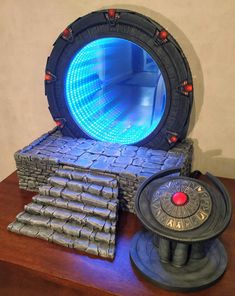
Introduction
Stardates are a unique way of measuring time within the Star Trek universe. They became a central part of the franchise’s lore, capturing the imaginations of fans who wanted to dive deeper into their favorite science fiction world. But how does one calculate a stardate? In this article, you’ll learn not only how stardates were conceived but also how to calculate them for various applications or even your personal use!
The Origin of Stardates
The stardate concept was first introduced in the original Star Trek series (1966-1969) as a way to keep track of time in an entirely new and fascinating approach. Gene Roddenberry, the creator of Star Trek, wanted a system detached from Earth’s calendar and felt it was important for consistency across episodes. However, little semblance of a standardized formula was maintained throughout the different series, making the process a bit more complex.
Calculating Stardates: The Classic Series
In the original series, one can observe that each stardate is formed by four digits followed by a decimal point and then one other digit (e.g., 1312.4). A thousand units indicate one Earth year. It is still unclear how each digit relates to time measurement.
Nonetheless, fans have developed their own formula, often referred to as “TOS Stardate Formula,” which can be calculated by taking the air date in YYYY-MM-DD format and applying this equation:
Stardate = (YYYY – 2323) * 1000 + MM * 100 / 12 + DD * 100 / 365
Keep in mind that this calculation isn’t canonical but rather fan-based.
Calculating Stardates: The Next Generation Era
When The Next Generation (1987-1994) came around, a more systematic approach to stardates was employed. Stardates in this iteration were four digits followed by a decimal and one or two additional digits (e.g., 41153.7). Each 1,000 units represent one Earth year, and the first digit represents the century the story occurs in. For example, TNG takes place in the 24th century, so stardates begin with a “4.”
The simplest formula to calculate stardates during this era is:
Stardate = (YYYY – 2323) * 1000 + Day_of_Year
This calculation uses the day of the year as a decimal portion of the Earth’s calendar.
Calculating Stardates: Other Series
Unfortunately, Star Trek: Deep Space Nine and Voyager followed no specific rules for calculating stardates. A general rule of thumb is to adapt the TNG formula and adjust it relative to other known stardates within those series.
Calculating Stardates: Star Trek Online
For users interested in calculating stardates for Star Trek Online, there’s an easy-to-use conversion tool available at [insert online converter URL here]. Simply enter your current date and let the applicatio_ do the conversion for you.
Calculating stardates can be quite fascinating for Star Trek fans who want to immerse themselves further into their beloved fictional universe. Though a standardized approach was absent from different Star Trek iterations, fans have kept the spirit alive by developing their own formulas, ensuring that stardates will continue to live long and prosper.
How to Clean a Cast Iron Stove: ...
3 ways to deal with a lazy ....
Matthew Lynch
Related articles more from author.

How to Dress Punk: 12 Steps

How to Learn English

How to Make Ravioli

3 Ways to Harvest Cotton

How to Turn Off Roku: 9 Steps


How to Act Around Your Boyfriend
Star Trek: What Is A Star-date?
It’s about ‘time’ this Star Trek concept was properly explained.
Over the years, Star Trek has cemented itself as one of the cornerstones for the sci-fi genre, setting a tread in the late 60s that carries through strongly even today. While the show may have had its ups and downs, the recent surge of new Trek content hitting Paramount+ shows that the franchise is alive and well, appealing to fans new and old. At its heart, the wild and wonderful universe found within these shows and movies is one that is overflowing with details and dedication. It features everything from fantastic, real-world-altering technologies , to the inclusion of vastly unique alien races and cultures. Despite the show's creators desire to make everything as grounded and realistic as possible, a few things fall through the gaps, lacking in the usual Star Trek logic normally so rife throughout the franchise. One such concept is the often quoted ‘Star-date’.
While the specifics of what exactly a Star-date is may elude the majority of casual viewers, it has become as intrinsic to the show as the famous transporters or warp drive, normally featuring at least once per episode since the show's creation. While its use within narrated captain's (and crew members') logs have waned in recent years, it used to be a real staple. Picard is potentially the most famous user, and implementer, of the concept, starting the majority of episode with the phrase.
RELATED: Star Trek: What Exactly Are Photon Torpedoes?
The idea behind the concept is fairly simple: they are a means of stating the date. It’s a way for the Federation to establish a more universal, standard method of timekeeping rather than relying on the plethora of different time zones of its members. On Earth alone, there are 24 different time zones, each of these using human/Earth-specific methods of measuring time. When adding more and more cultures into the mix, each from different planets with likely vastly different concepts of time, it’s clear how impossible it would be for the Federation to juggle them all. And so, Star-dates were born. This method of tracking time relied on the tracking of regular external elements, such as solar pulsars and natural events, rather than internal, culture-specific time tracking.
The layout is fairly simple. The large number at the start indicates how many days have passed, where the following number indicates the specific time within the day. For example, take ship's counselor Deanna Troi ’s mouth: "Counselor Deanna Troi, Personal Log, Star-date 44805.3. My mother is on board." It has been 44805 days since the creation of Star-dates, and the time is 3.
This all becomes a lot more complicated, however, as it is never fully specified the specifics in how Star-date time works. Is this 3 in the morning, or is this just the third hour of the day — if hours are the same as hours in the real world? The lack of a sunrise and sunset makes this all possible, the ship running in watch rotations, making the notion of ‘3’ being early or late in the day entirely subjective to that person's shift pattern. Audiences are also never given a clear inclination as to how long a star-day is, but again, this is entirely irrelevant to life aboard a spaceship that can theoretically choose a day time.
The non-universe reason as to why Roddenberry chose to use Star-dates in the franchise comes from his initial desire to avoid precisely establishing when the show is set. It’s supposed to be the distant future, but as audiences have seen, sometimes media set in these then-distant futures, riddled with high-tech gadgetry, have come and gone. Back to the Future 2 ’s future being set in 2015 being a prime example. The franchise would later give more specifics as to how far into the future they were, but at the start, Roddenberry was specifically against it. He wanted to allow for it to be the distant future no matter when the show was watched.
The other necessity behind creating the Star-dates was to avoid having to accurately give clarification as to how long things took. The lack of a precise and trackable watch meant that the show never had to divulge how long it took for them to travel at warp from, say, Earth to Romulus. This allowed for far more creative liberties and avoided a lot of continuity headaches, especially in the early days of the franchise.
It’s worth mentioning that the Kelvin universe films (in another example of complete disregard for a core element of the original franchise ) chose to use a different Star-date system. This one put the actual earth year at the start, and then gave a percentage that accounted for how far into the year they were. For example, July 2nd, 2360 would be 2360.50, as this is 50% though the year.
At the end of the day, the use of Star-dates through the franchise helps give logical credibility to the ever expanding world of Star Trek . There are a lot of gaps in the official creation and use of the specifics, but it’s the type of futuristic necessity that makes the universe feel so alive.
MORE: Jensen Ackles As Batman: Could It Happen In the DCU?

- April 11, 2024 | Paramount Pictures Officially Confirms Star Trek Origin Movie For Its Upcoming Film Slate
- April 11, 2024 | Recap/Review: ‘Star Trek: Discovery’ Tries Too Many Connections In “Jinaal”
- April 10, 2024 | ‘Star Trek: Discovery’ Season 5 Preview Offers Intriguing Clues And The Return To [SPOILERS]
- April 10, 2024 | Mary Wiseman Really Doesn’t Want To Talk About Tilly Returning On ‘Star Trek: Starfleet Academy’
- April 9, 2024 | Sonequa Martin-Green Talks About Exhausting Last Day On Set For ‘Star Trek: Discovery’
‘Star Trek: Prodigy’ Producers And Cast Explain Stardates And More From “Time Amok”
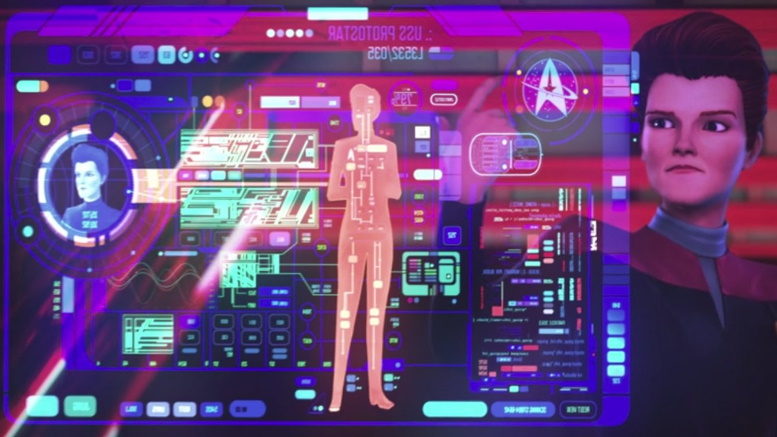
| January 24, 2022 | By: TrekMovie.com Staff 10 comments so far
[SPOILERS FOR PRODIGY 108]
The eighth episode of Star Trek: Prodigy, “Time Amok,” ventured into Star Trek’s time anomaly sub-genre. Since then, Paramount+ and the team behind the show have revealed more insights into the episode and explained a Stardate mystery.
Prodigy Stardate mystery
Prodigy ‘s time setting has been said to be 2383, or five years after the USS Voyager returned from the Delta Quadrant. However, “Time Amok” was the first time on the show that a stardate was given, and it was a bit curious. The episode started with Holo Janeway saying the stardate was 607125.6 which, according to how stardates work , would put it well beyond 2383. Co-executive producer Aaron J. Waltke explained this wasn’t an error, but a clue. He also promised an accurate stardate will be revealed.
For those curious what the ACTUAL Stardate is… you'll get one in the finale, don't worry! #StarTrekProdigy pic.twitter.com/FJjXonSkSs — Aaron J. Waltke (@GoodAaron) January 20, 2022
“Time Amok” writer broke new ground
Executive producers Dan and Kevin Hageman revealed that episode writer Nikhil Jayaram actually included the oscillating time graph in his script, which they explained is something not done in the business. Waltke followed up to say it was a first for the studio, but they welcomed it.
Screenwriting gurus frown upon putting graphs in your script, but @nsjayaram did. Here's a peek behind the curtain for #StarTrekProdigy 's Ep8 "Time Amok". pic.twitter.com/lRMhUBs8Un — Dan & Kevin Hageman (@brothershageman) January 22, 2022
They also gave a shout-out to show consultants David Mack and Dr. Erin Macdonald for their help on getting both the real and the Star Trek science correct.
Shout out to our Trek consultants who make it look like we know what we’re doing. We are always in your debt @DavidAlanMack and @drerinmac . Science is rad. #StarTrekProdigy — Dan & Kevin Hageman (@brothershageman) January 21, 2022
Mulgrew on Rok-Tahk’s lesson
The weekly lesson from Kate Mulgrew for “Time Amok” focused on the message to believe in yourself, as seen in Rok Tahk’s story.
Rylee’s time to shine
“Time Amok” focused a lot on the character of Rok-Tahk, and the Hagemans took to Twitter to praise the work of voice actress Rylee Alazraqui.
Tonight's #startrekprodigy Ep7 "Time Amok" is very close to our hearts. While we adore all of our voice actors, one in particular just flat out slays it. Also, massive shoutouts to our brilliant writer @nsjayaram and our superstar directors @SungShin3 and Olga Ulanova. 🖖⏲️⌛️🎆 — Dan & Kevin Hageman (@brothershageman) January 19, 2022
Later, Alazraqui revealed the “Time Amok” script was used for her audition.
I love being on Star Trek Prodigy so much! I actually read some lines from the episode “Time Amok” for my initial voice audition for the show. Fun fact! I am so incredibly grateful to play Rok! -Rylee ❤️❤️🤍 — Rylee Alazraqui (@rylee_alazraqui) January 22, 2022
Would hugging Rok-Tahk hurt?
“Time Amok” got Star Trek biology science consultant Dr. Mohamed Noor wondering about Rok-Tahk and what it would be like to hug a Brikarian. Aaron Waltke chimed in to say Brikarians would be analogous to one of his former pets. (And Dr. Noor replied that he had the same pet.)
I think we establish that Brikars are hard/denser than most species. But speaking as someone who owned a pet hedgehog as a child, that doesn’t preclude her from getting affection; just be gentle! — Aaron J. Waltke (@GoodAaron) January 21, 2022
Angus explains warp
“Time Amok” featured a lot of scenes in the engine room, so this week’s Star Trek tech video (delivered by the voice of Zero, Angus Imrie) was all about warp drive.
New episodes of Prodigy premiere on Thursdays on Paramount+ in the U.S. and on CTV Sci-Fi Channel in Canada, where it’s also available to stream on Crave . It is available on Paramount+ in Latin American, the Nordic Countries, and Australia on Fridays. It will debut later in 2022 in parts of Europe with the launch of the Paramouint+ Sky partnership .
Keep up with the Star Trek Universe at TrekMovie.com .
Related Articles

Star Trek: Prodigy
‘Star Trek: Prodigy’ Creators Say “Miscommunication” Led To Unexpected Early Release Of Season 2 In France

All Access Star Trek Podcast , Discovery , Lower Decks , Star Trek: Picard , Star Trek: Prodigy , Starfleet Academy , Strange New Worlds
Podcast: All Access Goes To SXSW For The ‘Star Trek: Discovery’ Season 5 Premiere

Conventions/Events/Attractions , Star Trek: Prodigy , VOY
Robert Picardo Says The Doctor Isn’t Just Comic Relief In ‘Star Trek: Prodigy’ Season 2

All Access Star Trek Podcast , Discovery , Star Trek: Picard , Star Trek: Prodigy , Strange New Worlds , VOY
Podcast: All Access Talks Skydance, ‘Picard,’ ‘Discovery,’ ‘Legacy’ Possibilities, And Highlights From Trek Talks 3
It would be cool if Prodigy could do a science lesson for the kids at the end of each episode, or maybe a separate show on its own. I would love to write them!
YES! I was hoping for something like that to be part of the show. There are many intriguing phenomena: twin stars, black holes, birthing nebulas, pulsars, post-nova voids etc… They could also tangle the microverse or quantum realm at some point.
The two science consultants for the franchise (physicist Erin McDonald and biologist Mohamed Noor) do have a YouTube channel that covers science in the various series.
However, targeted 5 minute science bites associated with each Prodigy episode would be a nice complement to each of the Prodigy episodes. It would be nice to have those posted on P+ along with Mulgrew’s featurettes on the social lessons from each episode.
That would have been fantastic, and the perfect vehicle for it.
I am starting to think maybe this show is taking place farther in the future than they are letting on. Why would you wait until the finale to show a stardate?
And it could explain why we are now seeing so many species in the Delta quadrant now like the Ferengi, Klingons, etc along with the alpha quadrant characters on the ship. Maybe after Voyager came home they found other means to get to the Delta Quadrant faster after a decade or two of research.
This show may actually be taking place in early 25th century and that time travel being involved is a red herring.
Or maybe it’s something else. Either way, I have to admit this ‘kids show’ has become a really intriguing show for me with both the basic story outlook and the ongoing mystery. It’s all done so well so far!
Didn’t they already feature a stardate in the “17 years ago” segment that worked out with the year the show is supposed to take place in?
But if they already showed us that stardate in the episode, then why are they now saying the ‘Actual’ stardate will be revealed later? Wouldn’t it just be the stardate 17 years later as implied? See what I’m getting at?
Clearly it’s not that straight forward.
Well, they haven’t shown a stardate for Prodigy’s present-day, at least I don’t remember one. Of course, they could do more time travel shenanigans. If not, the year should work out to what they said before the show started.
That’s what I mean though. Wouldn’t the statdate just be whatever it’s supposed to be 17 years later? Why keep that a secret at all? Why are they being so coy over it? What am I missing?
To be honest I didn’t realize they weren’t referencing the statdates in each episode until now. That shows you how much I don’t care about statdates lol.
Nice, I guess, that they are putting in that kind of effort for something as innocuous as the star dates. But honestly I never paid them any real attention as they were never important.
New Star Trek Prequel Movie Is Officially Official, Andor And Black Mirror Director Confirmed
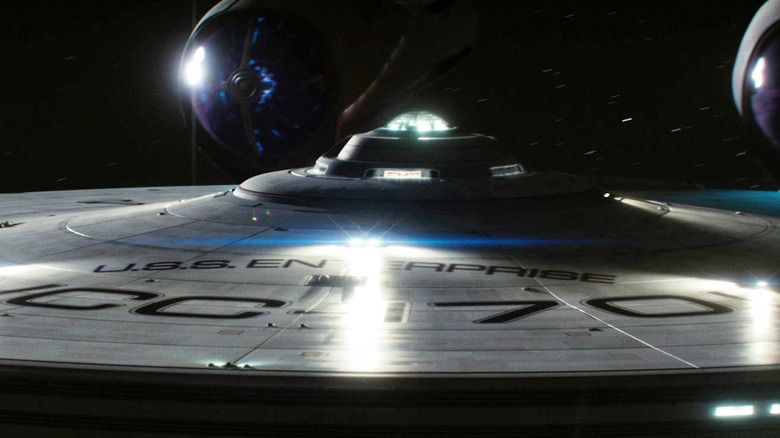
Captain's Log: Stardate 2024. It's been eight years since the USS Enterprise's last voyage on the big screen, with the franchise having since returned to its roots on television. During that period, the property has proliferated thanks to an influx of streaming series that's included everything from a "Next Generation" reunion to a raunchy cartoon and a wonderfully silly musical episode . But through it all, the question has lingered: when will Trekkies get to undertake another mission painted on the largest canvas available?
It's not been for lack of effort on Paramount's part. Ever since the commercial disappointment of 2016's "Star Trek Beyond" brought the escapades of the Kelvin Universe film series to a halt, the studio has cycled through one filmmaker after another in its quest to get "Star Trek" up and running in theaters once more. Most recently, it turned to "Black Mirror" director Toby Haynes to helm a new chapter based on a script by "Abraham Lincoln: Vampire Hunter" and "The LEGO Batman Movie" scribe Seth Grahame-Smith. At the same time, Paramount has continued to try and mount a fourth and final chapter in the Kelvin Timeline story that began with J.J. Abrams' "Star Trek" in 2009, having only barely recruited Steve Yockey ("The Flight Attendant") to work his magic on the screenplay.
Thankfully, we finally got an official update today during Paramount's CinemaCon presentation in Las Vegas (which /Film's Ryan Scott was there to witness with his own two eyes). The studio confirmed that Haynes' film will usher in the franchise's long-awaited return to theaters while, apparently, also functioning as a prequel to the previous Kelvin Universe movies. Production will begin later this year.
Star Trek will boldly go before it's never gone before
Literally winding back the clock for a mission is common practice in "Star Trek," so much so that the property even has a strict set of rules covering all the do's and don'ts of time travel (lest anyone step on a butterfly and wipe James Kirk out of existence). Prequels, on the other hand, only really came into vogue in the 2000s with the one-two punch of "Star Trek: Enterprise" and Abrams' film, the latter of which also introduced the alternate timeline known as the Kelvin Universe. Now, much as its big screen reboot 15 years ago served to reinvigorate the franchise while also appealing to a new generation of Trekkies, it's possible Paramount's goal here is for Haynes' prequel to revive the Kelvin series before bringing the main cast back while at the same time offering a jumping-on point for those who're new(ish) to the whole trekking across space thing.
Haynes' movie itself has previously been described as an "origin story" for "Star Trek" at large , which certainly supports the idea of it functioning as a soft reset without actually wiping out any earlier continuity (just like Abrams' movie). The director, for his part, has already demonstrated an appreciation for the property with his acclaimed "Black Mirror" episode "USS Callister" — a darkly satirical take on "Star Trek" tropes and toxic fandom — while his work on the "Star Wars" series "Andor" proves he's more than up for the task of taking a beloved sci-fi property and subverting it in fresh and exhilarating ways. With a little luck, these past eight years will prove to be more than worth the wait.
Keep it tuned to /Film for further updates on anything and everything "Star Trek."
William Shatner is beaming in to see the 2024 total solar eclipse from Indiana (video)
Captain Kirk got philosophical when speaking about the upcoming solar eclipse, saying it's not worth worrying about clouds.
BLOOMINGTON, Ind. — Of the many cities and small towns along the April 8 solar eclipse's path of totality, Capt. Kirk is only beaming down to one. Bloomington, Indiana, will play host to the original "Star Trek" captain, William Shatner.
Indiana University (IU) is marking the April 8 solar eclipse with the Hoosier Cosmic Celebration, a performance-packed event at IU's Memorial Stadium where some of the expected 300,000 visitors to Bloomington will watch the highly anticipated celestial alignment.
Shatner will be joined on the afternoon of April 8 by performers from IU's musical theatre and dance programs, as well as an appearance by retired NASA astronaut Mae Jemison and a concert by Janelle Monáe. As star-studded as the Cosmic Celebration is, Shatner is playing a critical role in the big day. The 93-year-old " Star Trek " actor and philanthropist will be performing a spoken word piece as part of the celebration's program, with his last words ending just as totality is beginning.
Related: Why I’m staying home for the April 8 solar eclipse
He spoke with Space.com and other local Indiana media ahead of his upcoming Indiana trip, and he noted the possibility of rain or clouds getting in the way of experiencing something wonderful.

What if the weather clouds out your solar eclipse?
William Shatner: It's the Sword of Damocles . It's the animal outside the door. And nobody talks about it because it's perfectly probable that there will be an enormous thunderstorm the instant the sun is eclipsed. It's also perfectly possible that it will be a clear, bright, lovely, warm spring day, and we will all enjoy the benefits of the Hoosier weather. What happens if it's cloudy? I don't know. It's like looking into the pit of a volcano saying, "What do we do about that thing?" And it's nothing can be done. There's nothing can be done."
Shatner spoke at length about the wonders of getting to see something as special as a total solar eclipse. It is, after all, a complete coincidence that the sun and moon appear relatively the same size in the sky.
That's not the case on many other worlds. For instance, scientists have witnessed Mars' tiny moon Phobos transiting the sun , as seen by the Curiosity rover from the surface of the planet, but the relative size of the moon and sun in the Martian sky don't create the same totality phenomenon seen during solar eclipses on Earth.
Get the Space.com Newsletter
Breaking space news, the latest updates on rocket launches, skywatching events and more!
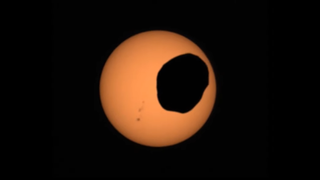
What does this solar eclipse mean to you?
Shatner: One of the curses, and one of the benefits of humanity is our curiosity. And we'll never overcome that curiosity. "What's there? Why is it hiding?" I mean, even this eclipse, "How did it happen? Oh, you mean a great big piece of debris...brushed up against Earth, causing it to scoop out an amount of Earth to make the moon?" How do we know that, and how do we do that? How did we see it? I mean, the mystery of the beauty of our existence — to examine that is a voyage we all have to take...
To me, the magic of the eclipse, the extraordinary events it all took in the heavenly bodies to cause this eclipse, should make us ponder the mystery of existence, of our own existence, of the existence of everything else and how unified everything is...
The eclipse should bring about all of us thinking about the mystery of existence. And the beauty of the fact that we live and are able to observe it from this little rocky outpost called Earth, and how valuable that is to keep alive, to keep healthy, because that's why we are alive. So this event, the eclipse, should bring about a whole manifestation of the mystery of everything...
It's going to be so much fun-filled, with some of the answers to the mysteries and some of the mysteries posed as questions. You'll have a great time.
— Total solar eclipse April 8, 2024: What you'll see if you're outside the path of totality
— These 15 solar eclipse beers were brewed to sip in the path of totality
— What time is the total solar eclipse on April 8?
The total solar eclipse on April 8 will sweep across the United States from Texas to Maine, passing through Indiana around 3 p.m. EDT, with Bloomington experiencing 4 minutes and 2 seconds of totality between 3:04:50 p.m. EDT and 3:08:53 p.m. EDT. The forecast is calling for partly cloudy skies in Bloomington on April 8, but, like the captain said, "There's nothing can be done."
Join our Space Forums to keep talking space on the latest missions, night sky and more! And if you have a news tip, correction or comment, let us know at: [email protected].

Josh Dinner is Space.com's Content Manager. He is a writer and photographer with a passion for science and space exploration, and has been working the space beat since 2016. Josh has covered the evolution of NASA's commercial spaceflight partnerships, from early Dragon and Cygnus cargo missions to the ongoing development and launches of crewed missions from the Space Coast, as well as NASA science missions and more. He also enjoys building 1:144 scale models of rockets and human-flown spacecraft. Find some of Josh's launch photography on Instagram and his website , and follow him on Twitter , where he mostly posts in haiku.
Top total solar eclipses to look out for over the next decade
What it was like to chase totality in South Texas
A NASA spacecraft spotted something weird orbiting the moon. It was just a lunar neighbor (photos)
Most Popular
By Jamie Carter April 11, 2024
By Mike Wall April 11, 2024
By Robert Z. Pearlman April 11, 2024
By Joe Rao April 10, 2024
By Robert Lea April 10, 2024
By Mike Wall April 10, 2024
By Brett Tingley April 10, 2024
By Jamie Carter April 10, 2024
By Jeff Spry April 10, 2024
By Robert Z. Pearlman April 10, 2024
- 2 Monster star gains magnetic personality following stellar merger
- 3 Car-sized asteroid is giving Earth a really, really close shave. But don't worry.
- 4 'Star Wars: Tales of the Empire' sets surprise May the 4th debut on Disney Plus (video)
- 5 Gravitational waves reveal 1st-of-its-kind merger between neutron star and mystery object
- More to Explore
- Series & Movies
Published Apr 2, 2024
What to Expect from The Final Season of Star Trek: Discovery
The cast details everything you need to know to get ready for the Season 5 premiere this week!

Getty Images / StarTrek.com
The highly anticipated fifth and final season of Star Trek: Discovery arrives this week!
This season finds Captain Burnham and the crew of the U.S.S. Discovery uncovering a mystery that will send them on an epic adventure across the galaxy to find an ancient power whose very existence has been deliberately hidden for centuries. But there are others on the hunt as well… dangerous foes who are desperate to claim the prize for themselves and will stop at nothing to get it.
Ahead of the premiere, StarTrek.com had the opportunity to speak with series cast Sonequa Martin-Green (Captain Michael Burnham), Doug Jones (Saru), Anthony Rapp (Paul Stamets), Mary Wiseman (Sylvia Tilly), Wilson Cruz (Dr. Hugh Culber), David Ajala (Cleveland "Book" Booker), Blu del Barrio (Adira), along with this season's recurring guest star Eve Harlow (Moll) and executive producer and co-showrunner Michelle Paradise . With their help, here's what you can expect from their characters this season!
In case you need a quick refresher before we dive forward, we've got a handy Where We Left Off guide !
Now let's fly!
Sonequa Martin-Green on Season 5 Stakes and Captain Michael Burnham's Relationship Status

"Red Directive"
StarTrek.com
"This season, we can expect a wild ride," teases Sonequa Martin-Green. "One of the things that they wanted to do was that they wanted to have a tonal shift. They wanted it to be adventurous, they wanted it to be fun, they wanted it to be kind of like the Indiana Jones season. And so we really did that. We really did that. The artistry is on another level."
"In every department, you will see some really incredible things coming to life," continues Martin-Green. "In Season 5, we did some stuff we should not have been able to do; we did some stuff that we've never done before. I'm really proud of every department, of every cast member, of every crew member, every writer, every producer, every post-production coordinator, and supervisor, and worker. We took it to the next level without even knowing that it was our last season. When everyone sees it, I think that they'll see what I'm talking about. It's culminating because of that; it is just on another level. It's a huge, huge season. People have a lot to look forward to."
Addressing where Michael Burnham and Book find themselves at the start of this season, Martin-Green explains, "Book and Burnham, they are the classic, old Facebook status of 'It's complicated.' They've got a lot to work through. That's where we pick up with them, having not been speaking as regularly as they normally do. Of course, we see that he was sent off at the end of Season 4. Now they are back in each other's midst, and they have got a lot to talk about and a lot to wade through. It's very complicated between them. There's obviously still that love, that deep love, that bond, that respect, but they've got a lot to work through."
Doug Jones on Saru's Next Step
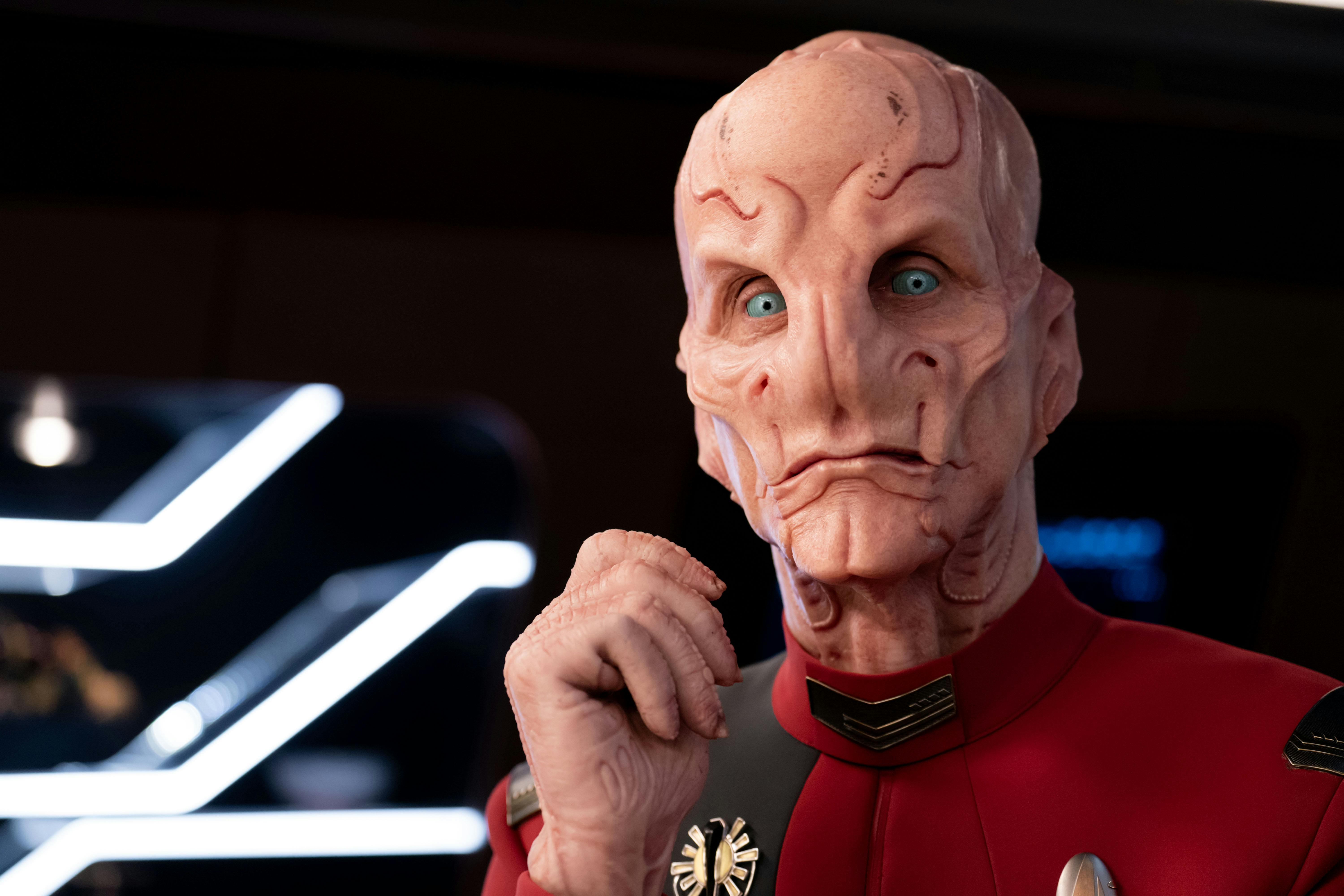
"Under the Twin Moons"
Reflecting on Saru's journey across the entire series, Doug Jones reveals, "Saru had been captain of the ship for Season 3. And Season 4, he then kind of took a step to First Officer again, because of his loyalty to Michael Burnham, and the special task we were on throughout the season."
"Well, now he’s [re-evaluating] his purpose there," adds Jones. "Has it run its course? His relationship with President T’Rina, played by the lovely Tara Rosling. She does come into the equation with how he makes his decision."
Anthony Rapp on Paul Stamets' Legacy and Season 5 Baddies

Episode 506
"This season, you can expect a new level of inquiry for Paul about what's next for him in terms of the work that he wants to do," hints Anthony Rapp. "He's an incredibly driven and brilliant human being with this mind, that's some level of genius. You get to see him like stretch himself in new ways."
What does the Discovery crew make of arrival of this season's antagonists — Moll (played by Eve Harlow) and L'ak (played by Elias Toufexis)?
"I really love the description of this kind of Bonnie and Clyde," shares Rapp. "It was fun for us, or for me, I could speak for myself, to have these kind of iconic touchstone archetypes brought into our show. Their energy as people; [Eve Harlow and Elias Toufexis] brought a beautiful energy to the company to being a part of our show and being a part of our story. And then their work was exceptional. To have this, this idea of this kind of like maverick couple that's on the run is a cool one. And there's a reason it's iconic. And I think that the way that our writers threaded it through our story was really well done."
Mary Wiseman on Sylvia Tilly's Career Focus

"Tilly's in a great place," notes Mary Wiseman. "She's found a certain kind of assurance from going off to teach at Starfleet Academy, and coming back feels like coming home. You're a little cooler and a little more adult. And people call you 'Miss.'"
However, that's not without some challenges. "But she kind of also feels stuck with the problem about how to get through to these kids that have grown up in this era where there isn't the sort of interconnectedness, galaxy-wide communication, and transportation possibilities that there were when she was growing up," highlights Wiseman. "And she's kind of noticing it in the kids' behavior, and inability to interact or team build. And so that's something that she kind of wants to work on and figure out how to help them out with that."
Wilson Cruz on Dr. Hugh Culber's New Experiences

Episode 505
"Where we first find Culber in Season 5, he's in a really good place," notes Wilson Cruz. "He's really embodied this new version of himself, and is ready and willing to take on whatever he's confronted with."
Cruz continues, "This season, he is confronted with an experience that forces him to ask even more existential questions that kind of blows his mind. It starts him on knowing about all of the mysteries of the universe. This whole mission really makes him question a lot of things. We see him process a lot of that throughout the season."
David Ajala on Cleveland "Book" Booker's Love for Burnham and Season 5 Action Sequences
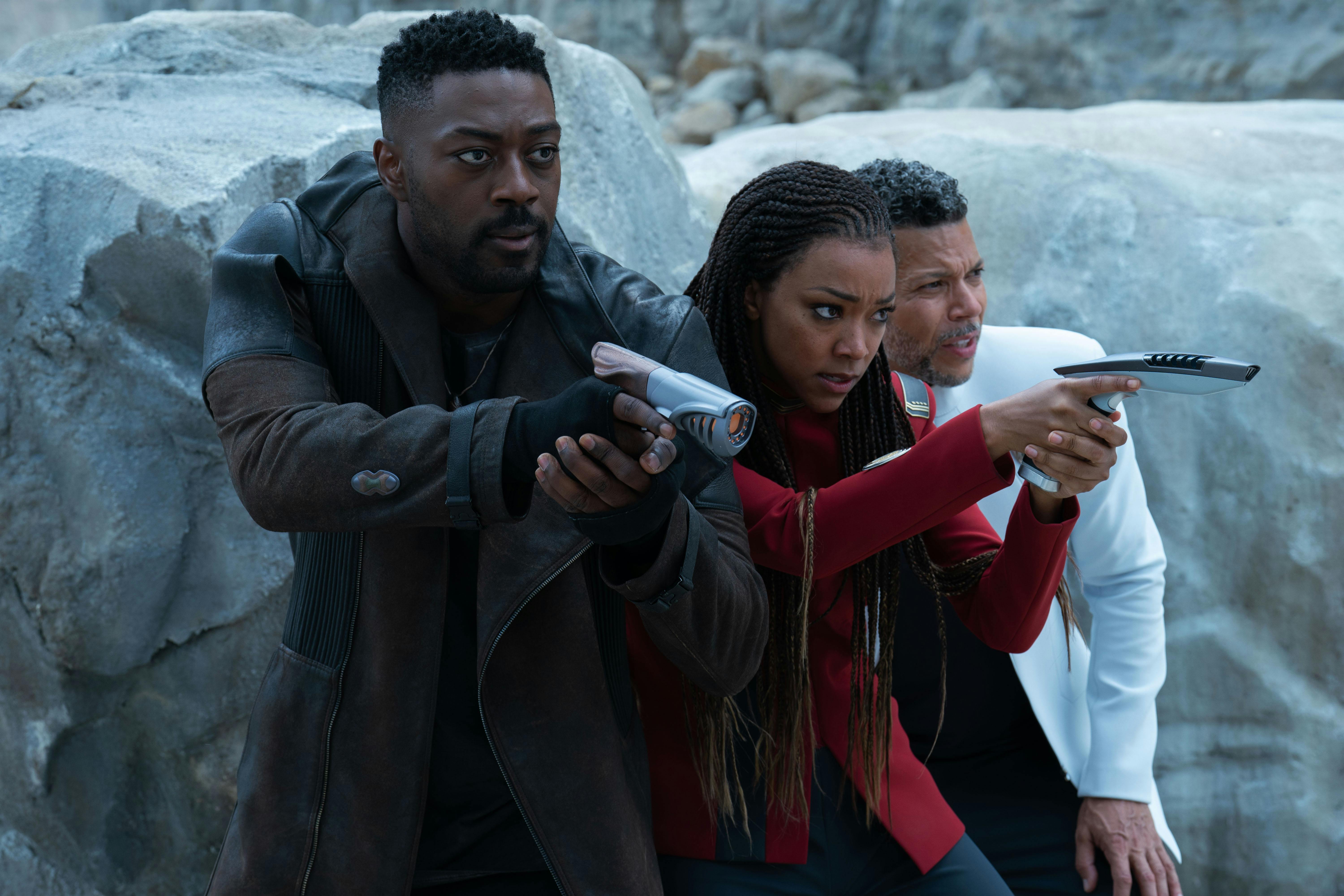
Episode 503
Following the events of Season 4, Book must walk away from Burnham. Reflecting on his actions and headspace at the start of this season, David Ajala states, "It's interesting, because, if we're talking about the gift of grace, Book has definitely received grace from Michael Burnham. Even though Book made the decision that he thought was right, it was not even honorable, but he felt duty bound to do what he did. He was still afforded grace by Michael Burnham, to be welcomed back with open arms. The journey of someone like Cleveland Booker, who was very driven by keeping his autonomy, and also serving his purpose on the planet, which was to help endangered species, to be a part of Starfleet, it was never something that was within his remit. But then to come full circle in Season 5, and to see him, organically incorporate himself within that team is a wonderful story."
"Where we left off in Season 4, revisiting and coming back for Season 5, it's a different territory for both of them," explains Ajala. "And yet, they both have to acknowledge that they're in different spaces, but then still show a level of care for one another. This grey area is new territory."
As for the Indiana Jones -level of excitement the series explores this season, Ajala details, "I love action, I love being able to be physical, to express myself. Having said that, I love the way action is used in the right way. And because this is the final season, we could have taken like one to potentially three episodes to kind of warm into it. But with the first episode, we were straight in with high octane, big action sequences, and just a real spectacle to observe."
Blu del Barrio on Adira's Growing Confidence

"Adira starts out in a pretty solid looking place," reveals Blu del Barrio.
"On the outside, they look and seem really good," adds del Barrio. "They have a lot more responsibilities on the ship. And they're taking their work very seriously, and just very happy to be like more integrated. But underneath the surface, they're struggling a little bit more with some emotional stuff and some major personal stuff."
Eve Harlow on the Arrival of Star-Crossed Lovers and Joining the Cast of Discovery
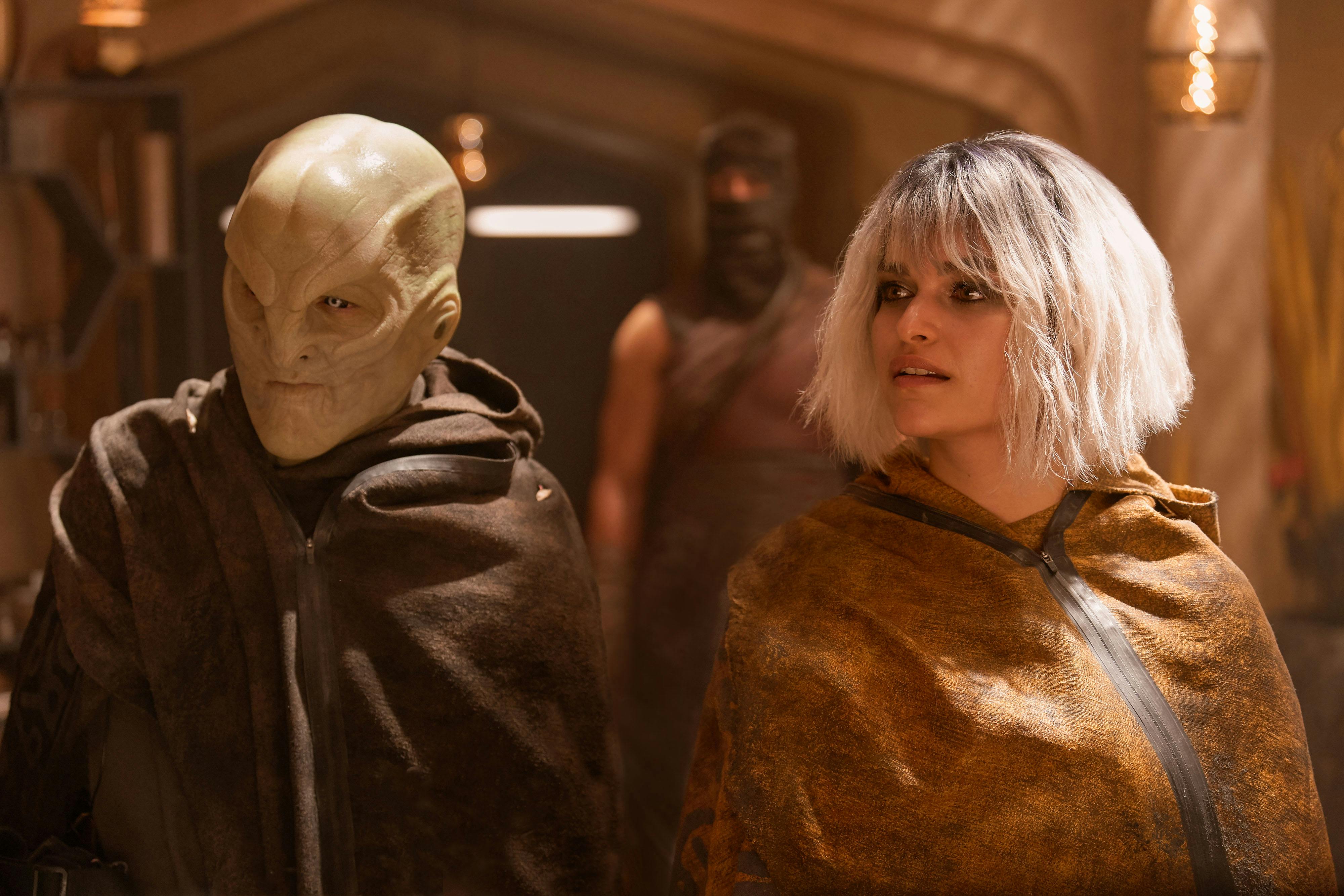
During NYCC 2022 , audiences got to learn about this season's baddies. Moll and L'ak are former couriers turned outlaws. Moll is highly intelligent and dangerous, with an impressive strategic mind and a sharp wit. She goes into every situation with a clear plan and stays focused and clear-headed on her goal, even when things go awry. She’s not easy to intimidate, and will face down anyone who stands in her way in order to get what she wants. Whereas L'ak is tough, impulsive, and fiercely protective of his beloved partner, Moll. So long as he knows she’s safe, he doesn’t care about collateral damage or its consequences — a perspective that makes him very dangerous at times and will put him on the opposite side of Captain Burnham and the crew of the U.S.S. Discovery when they come into conflict.
Speaking directly to StarTrek.com on Star Trek: The Cruise VII, Eve Harlow divulges, "Moll is badass, and she and L’ak are an interspecies couple. It’s kind of breaking all the rules, which is why they’re on the run. It’s very much like Romeo and Juliet or Bonnie and Clyde because they’re star-crossed lovers."
On her experience of joining this series for its fifth season, Harlow offers tons of praises, "These are some of the kindest, just most welcoming people I've ever met. I feel like I just talk about how much I love Sonequa a lot, but I will keep talking about how much I love her. She is the best leader I've ever experienced on set."
"[When I reflected on] who on-set is most like their character in real life. Without skipping a beat, Elias and I, at the same time, were Sonequa. She is that captain, and she treats everyone like an equal. I've just never been on a set where everyone, the crew is so appreciated. She knows everybody's names. She knows what they do. She knows their family life, what's going on with them. She genuinely cares, and being around that, that spirit is infectious. Every single time I was on set. I was so high energy; I was just so happy to be here. And it's because of the people who were working on that show."
Michelle Paradise on Season 5's New Faces

"Elias [Toufexis] and Eve [Harlow] play L’ak and Moll who are our two new bad guys this season," states Michelle Paradise. "We talked about them as kind of a Bonnie and Clyde unit. We hadn't had a couple before as our antagonist. In turn, they're obviously formidable foes for our heroes. But we also really wanted to make sure that they felt well-rounded, and that they weren't just one note, bad guys. We understood the why of what they were doing the depth of their love for one another. People will be surprised that they may start rooting for these bad guys, actually. But they'll never want them to win more than our heroes, of course. It’s a lot of fun to have them."
L'ak and Moll aren't the only new faces this season. Rayner, also previously announced at NYCC 2022, is a gruff, smart Starfleet captain who holds a clear line between commander and crew — he leads, they follow. Rayner’s all about the mission, whatever it may be, and he doesn’t do niceties along the way; his feeling is, you get the job done and apologize later. He has a storied track record of wartime success, but in times of peace, he struggles. Collaboration is not his strong suit. That said, if it serves the greater good he’s willing to learn... but it won’t be easy.
"And then Callum Keith Rennie plays Captain Rayner," elaborates Paradise. "What's interesting about him is that he is going to be a bit of an antagonist, but not in a bad guy way. He's going to push Burnham, and we'll get to see new sides of Burnham and new growth in Burnham because of her interactions with him. It's a really interesting dynamic there. That's one of the things that we always look at, if we're going to bring in any new guest characters, is how can they impact our regulars? And how can they help our regulars grow over the course of the season or change or help us see new sides of them, and these three do that beautifully."
Get ready for Discovery 's final adventure when Season 5 premieres with the first two episodes later this week!
Get updates by email.
Christine Dinh (she/her) is the managing editor for StarTrek.com. She’s traded the Multiverse for helming this Federation Starship.
Star Trek: Discovery Seasons 1-4 are streaming exclusively on Paramount+ in the U.S., the UK, Canada, Switzerland, South Korea, Latin America, Germany, France, Italy, Australia and Austria. Seasons 2 and 3 also are available on the Pluto TV “Star Trek” channel in Switzerland, Germany and Austria. The series streams on Super Drama in Japan, TVNZ in New Zealand, and SkyShowtime in Spain, Portugal, Poland, The Nordics, The Netherlands, and Central and Eastern Europe and also airs on Cosmote TV in Greece. The series is distributed by Paramount Global Content Distribution.

- Where to watch in the US
- Where to watch in Canada
- Where to watch in New Zealand
- How to watch from anywhere
- How to watch with a VPN
Other Star Trek shows
Where to watch star trek: discovery free — final season is underway.
When you buy through our links, Business Insider may earn an affiliate commission. Learn more
The newest season of Star Trek: Discovery is officially underway. Season 5 marks the final season of the Star Trek spin-off, and it's shaping up to be an action-packed swang song. Whether you're looking to stream the new episodes or get caught up on the past four seasons, we've got everything you need to know about the show, including where to watch Star Trek: Discovery free via a TV channel abroad.
Star Trek: Discovery premiered in 2017 and follows in the decades-long tradition of Star Trek stories. The series is set about five years before the original Star Trek, which chronicled Captain Kirk's five-year journey. In Star Trek: Discovery, the U.S.S. Discovery travels through space on a mission of exploration. Season 5 sees Captain Burnham (Sonequa Martin-Green) and the U.S.S. Discovery crew on the hunt for an ancient power that others are also seeking.
The first three episodes are currently streaming. Keep reading to learn how to watch the series no matter where you are in the world.
- Where to watch American Horror Story | Where to watch 9-1-1 | Where to watch Game of Thrones
Where to watch Star Trek: Discovery in the US
New Season 5 episodes of Star Trek: Discovery land on Paramount+ on Thursdays. The premiere week included two episodes, and now one new episode will drop weekly. Episodes should be available starting at about 3 a.m. ET. All four past seasons are available to stream through the service. Subscriptions start at $5.99 a month and come with a one-week free trial.
Paramount Plus' Essential tier is a steal at this price and only has limited ads. It features tons of on-demand content from Paramount, CBS, Nickelodeon, Comedy Central, BET, and MTV. And you get NFL and Champions League soccer live streaming. There's a 7-day free trial, then it's $6 a month or $60 a year. The only way to ditch the ads is by opting for the Showtime bundle.
Where to watch Star Trek: Discovery in Canada
Paramount+ is also the home to Star Trek: Discovery in Canada. Plans start at CAD$6.99 and come with a one-week free trial. All episodes are available to stream here.
Where to watch Star Trek: Discovery in New Zealand
Star Trek: Discovery is available to stream for free on TVNZ+ . You'll need to create a free account to start streaming. In addition to new season 5 episodes, Seasons 1-4 are also streaming on the site. New episodes are available on Thursdays.
How to watch Star Trek: Discovery from anywhere
If you're not in New Zealand at the moment, you can access streams with a VPN (virtual private network). VPNs alter your electronic device's location so you can use websites that might not be available in certain regions. They're also solid ways to boost your online privacy. We recommend ExpressVPN , a user-friendly option with a 30-day money-back guarantee. Check out our ExpressVPN review for additional details and see below to learn how to use a VPN.
With its consistent performance, reliable security, and expansive global streaming features, ExpressVPN is the best VPN out there, excelling in every spec and offering many advanced features that makes it exceptional. Better yet, you can save up to 49% and get an extra three months for free today.
How to watch Star Trek: Discovery with a VPN
- Sign up for a VPN if you don't have one.
- Install it on the device you're using to watch Star Trek: Discovery.
- Turn it on and set it to New Zealand.
- Go to TVNZ+ and create a log-in profile.
- Watch Star Trek: Discovery.
If you're sad that this is the final season of Star: Trek Discovery and can't get enough of the franchise, there are multiple other series you can check out. Star Trek: Picard wrapped its third and final season in 2023 and Star Trek: Strange New Worlds (a spin-off from Star Trek: Discovery) is slated to release a third season next year. Like Discovery, Picard and Strange New Worlds are Paramount+ originals and are available to watch on the streamer. Paramount+ is also the streaming home to several other older Star Trek series, including the original Star Trek, Star Trek: The Next Generation, Star Trek: Voyager, Star Trek: Deep Space Nine, Star Trek: Enterprise, and more.
Note: The use of VPNs is illegal in certain countries, and using VPNs to access region-locked streaming content might constitute a breach of the terms of use for certain services. Insider does not endorse or condone the illegal use of VPNs.
You can purchase logo and accolade licensing to this story here . Disclosure: Written and researched by the Insider Reviews team. We highlight products and services you might find interesting. If you buy them, we may get a small share of the revenue from the sale from our partners. We may receive products free of charge from manufacturers to test. This does not drive our decision as to whether or not a product is featured or recommended. We operate independently from our advertising team. We welcome your feedback. Email us at [email protected] .

- Main content
Why 'Star Trek: Discovery' deserves more credit as a barrier-breaking series
Starship Discovery will soon be ending its mission, and what a journey it's been.
“Star Trek: Discovery,” which premiered in 2017, is entering its fifth and final season Thursday on Paramount+. And you’ll need the Captain’s Log to remember all the twists, turns and transformations the show has gone through since it began.
One thing that hasn’t changed, though, is the hate the series has received from some Trek fans. (“Discovery” has an overall audience score of 37% on Rotten Tomatoes, a stark difference from the 87% critic rating.)
While the show is far from free of legitimate criticism, many of the complaints seem unfairly – though perhaps tellingly – placed on the show’s focus on a Black woman commander, its LGBTQ+ stars and allies and its inclusive storylines. “Woke agenda” and other dog whistles frequently surface on Reddit and social media posts about the series.
That so much of the negativity is rooted in a backlash against inclusivity raises questions. After all, the "Star Trek" franchise has long emphasized and celebrated culture, diversity and humanity coming together and preserving the integrity of beings they meet across the galaxy.
"It doesn't make any sense, because (these fans) say they love this franchise," series star Sonequa Martin-Green says in an interview. The show “has always been about breaking those boundaries. It's always been about diversity and equality. And our world has changed since the last iteration of 'Trek.' We have a responsibility to push that needle forward and to stay true to that."
More: Issa Rae says Hollywood needs to be accountable. Here's why diverse shows are so important
The series is originally set before the events of NBC's original “Star Trek: The Original Series” (later jumping to the future) and follows Michael Burnham (Martin-Green), who became the starship’s captain, and the rest of the crew of the USS Discovery: first officer Saru (Doug Jones), chief engineer Paul Stamets (Anthony Rapp), lieutenant and now Starfleet Academy teacher Sylvia Tilly (Mary Wiseman), medical officer Hugh Culber (Wilson Cruz), courier and Burnham’s love interest Cleveland “Book” Booker (David Ajala) and ensign Adira Tal (Blu del Barrio).
Many more characters have stood on the bridge, battled with Burnham, or otherwise make up the world of "Discovery." The series had some trouble finding the right footing, but it’s always had heart, especially in its recurring theme of redemption. And it deserves more support for what it has meant for the entire "Star Trek" franchise.
Here’s why “Star Trek: Discovery” deserves more credit:
Prioritizing diversity and inclusivity
A Vulcan philosophy (and one espoused by “Star Trek” creator Gene Roddenberry) is IDIC, or “infinite diversity in infinite combinations,” and many of the related series, movies and books underscore this belief. “Discovery” also has diversity at its core: the show focuses on a Black woman who becomes captain. Stamets and Culber are an openly gay couple, and engineer Jett Reno (Tig Notaro) is a lesbian. And the show introduced a few franchise firsts: Adira Tal as the first nonbinary character in "Star Trek ," and their boyfriend, Gray ( Ian Alexander ), is the first transgender character , both introduced in Season 3.
More: 'Star Trek' documentary unveils star Nichelle Nichols' impactful NASA connection
Starting a new age of Star Trek
“Discovery” helped launch the CBS All Access streaming platform, a CBS subscription service that would eventually become Paramount+, as well as a new era of "Star Trek" series including “Lower Decks” and “Picard.” Before “Discovery,” the last Trek series was “Star Trek: Enterprise,” which ended in 2005.
Exploring strange new worlds
The second season of “Discovery” also served as a launching pad for the well-received spinoff, “Star Trek: Strange New Worlds,” which resurfaced popular characters from the original series including Spock (Ethan Peck), Captain Pike (Anson Mount), Uhura (Celia Rose Gooding) and Number One (Rebecca Romijn).
Finding time for the simple things
In a few scenes scattered throughout "Discovery," we see characters like Culber and Stamets sharing a meal or talking about their day while brushing their teeth. It’s almost mundane, but there’s also something so lovely about watching LGBTQ+ characters who rarely are the focus in movies or television simply living their lives, being their whole selves. Burnham rocking braids at the beginning of Season 3 speaks cultural volumes. The subtle amid the big battles and overarching plots do have meaning, especially for those whose voices often go unheard.
Going boldly
The first season of “Discovery” went out of its way to highlight its connections to the original series: Burnham is Spock’s adopted sister, and there's a brief appearance by Spock’s father, Sarek. But it wasn’t always so neatly woven, sometimes seeming more like it was using franchise lore as a crutch. But “Discovery” wasn’t afraid to try new things, turning itself around after an overcomplicated first season and again after a very “TOS”-inspired second, slowly building up its own universe without relying too heavily on the old.
The first episodes of Season 5 are a little rocky before it settles into a comfortable speed.
"This time around, we wanted to bring in some levity," Martin-Green says. "But there's a grand sort of epicness to Season 5, even though we didn't know it was our last season when we were shooting it. I think looking back on it, and when we share it with the world, it'll seem that way because the season is so big. So people can expect a lot of fun. They can expect it to go really fast."
It will be interesting to see if “Discovery” sticks the landing through the remainder of the season.
“The good outweighs the bad,” Burnham says in an upcoming episode about a mission, and that’s also true of “Discovery."
The fifth and final season of "Star Trek: Discovery" (two episodes now streaming, then weekly on Thursdays) streams on Paramount+.

- Entertainment
- Rex Reed Reviews
- Awards Shows
- Climate Change
- Restaurants
- Gift Guides
- Business of Art
- Nightlife & Dining
- About Observer
- Advertise With Us
‘Star Trek: Discovery’ S5 Review: Final Season Is Its Best
This season has a brisk pace and the sense of fun that in the past has been crushed under the weight of grave galactic stakes..

Star Trek: Discovery occupies an interesting place in the celebrated franchise. It was the first Trek series of the streaming era, the first to debut behind a paywall, the first produced after J.J. Abrams’ big screen reboot, and the first to put a woman of color in the captain’s chair. Discovery redefined the look and feel of the franchise on television, bringing Trek into the modern world of feature-level photography, effects, and pace of story. It blazed a trail for a new generation of Trek media, like direct spin-off Strange New Worlds and the upcoming Section 31 TV movie. It is also not terribly popular amidst the old guard of Trekkies, nor is it a mainstream hit or a critical darling. Discovery has struggled to find its footing from the very beginning and is still uneven after years of retooling. I do not consider its cancellation after five seasons to be a tragic loss for television. However, Discovery may still have one “first” left to achieve: It may be the first Star Trek series whose final season is its best.
Sign Up For Our Daily Newsletter
Thank you for signing up!
By clicking submit, you agree to our <a rel="nofollow noreferer" href="http://observermedia.com/terms">terms of service</a> and acknowledge we may use your information to send you emails, product samples, and promotions on this website and other properties. You can opt out anytime.
(A quick personal note to the handful of Trekkies who just clutched their pearls: Season 4 of Enterprise is not better than Season 3, it merely has more familiar stuff for fans to point at with childlike glee. And you’ve likely already read my thoughts on Picard ’s final season .)
Even as a critic of the show, I have to acknowledge that every season of Discovery has started with a bang. It’s the nature of a serialized, season-long story arc to kick off with something resembling the first act of a feature film, and Season 5 is no different. The opening chapter, “Red Directive,” is a fast-paced space adventure packed with flashy action set pieces. The illustrious Captain Michael Burnham ( Sonequa Martin-Green ) and her crew are on the trail of Moll (Eve Harlow) and L’ak (Elias Toufexis), a spacefaring Bonnie and Clyde who have stumbled across a secret with enormous implications for the future of the galaxy. Just like the previous three seasons, this sets Team Disco off on another cosmic scavenger hunt, jumping to a new world each week to find the next clue to the season’s grander mystery.

Historically, this is where Discovery has run into trouble. While each chapter tends to have its own contained adventure plot or even a classic Trek “message of the week,” they’re rarely that memorable and they advance the season’s overarching storyline without adding much depth. This season, though, has a brisk pace and a sense of fun that, previously, has been crushed under the weight of grave galactic stakes. Paramount has promoted this season as having an Indiana Jones energy to it , and that’s a fair comparison. The characters are enjoying themselves more, and for the first time since Season 2, the story isn’t built around some unfathomable tragedy. T o my best recollection, none of the episodes provided in advance to critics feature any crying. That’s four consecutive episodes, possibly a new track record.
This is not the only way in which Discovery ’s new season throttles back on the show’s occasionally cloying sentimentality. The season premiere introduces a new character, Captain Rayner ( Callum Keith Rennie ), a gruff pragmatist who serves as a contrast to Burnham’s soft-spoken, personable, firmly feminine command style. At first, Rayner appears to be a straw man representing aggro, entitled white male authority, a trope Discovery goes to often. As the season progresses, Rayner acquires some depth and even some likability. It’s fun to watch this grumpy old guy interact with a cast full of characters who are totally in touch with their feelings. Most importantly, Rayner provides something that the series has needed ever since Burnham took command of Discovery: a professional peer with whom to disagree and occasionally compromise. It’s an essential role that her first officer, Saru ( Doug Jones ), has become too adoring and loyal to play. Burnham has earned the devotion of her crew, but watching her gracefully manage dissent only enhances her aura of strength and leadership.

Even though production was wrapped before Discovery was canceled (with additional shooting after that announcement to tie up loose ends), Season Five feels like a finale from the very beginning. A few characters are moving on with their lives, pursuing new interests and relationships. There are more fun, non-intrusive callbacks to Treks past than in the last two seasons, which makes it feel a bit like a victory lap for the streaming era’s flagship show. Above all, there is a sense of ease, as if the cast and crew have finally got their engine running smoothly and can cruise to the finish line. It’s the energy a series possesses at its peak, a point to which fans will often look back and say “They probably should have stopped there.” Barring a significant misstep in its final six episodes, Star Trek: Discovery will never be past its prime, and that’s a distinction its creators can wear with pride.

- SEE ALSO : How Opera’s Crisis Can Become an Opera Renaissance
We noticed you're using an ad blocker.
We get it: you like to have control of your own internet experience. But advertising revenue helps support our journalism. To read our full stories, please turn off your ad blocker. We'd really appreciate it.
How Do I Whitelist Observer?
Below are steps you can take in order to whitelist Observer.com on your browser:
For Adblock:
Click the AdBlock button on your browser and select Don't run on pages on this domain .
For Adblock Plus on Google Chrome:
Click the AdBlock Plus button on your browser and select Enabled on this site.
For Adblock Plus on Firefox:
Click the AdBlock Plus button on your browser and select Disable on Observer.com.

IMAGES
VIDEO
COMMENTS
OCT. NOV. DEC. YEAR: TIME: STARDATE: This application is based on the the LCARS user interface designed by Mike Okuda for Star Trek: The Next Generation. EARTH DATE. 13/05/2369 16:23.
Home Tools Star Trek : Stardate Calculator. Tool will convert standard dates to stardates and vice versa. access_time Stardate Calculator. Date. YYYY/MM/DD HH:MM. Calculate. Stardate: date_range Date Calculator. Stardate.
Calculate the Fiction Stardate of the Future! Select the wanted date (default is current date) and click the button "Start!". The Fiction Star Date is displayed in the field below. The basedate is Feburary 1, 2324 (Fiction Stardate 0). Type the Fiction Stardate you want to convert.
Expressing Contemporary Dates as Stardates Find the fictional Stardate that corresponds to "today's" date. Since the Stardate systems used in various Star Trek episodes are meant to measure time in the Twenty-third and Twenty-fourth Centuries, the same Stardate system cannot be used to express contemporary dates (i.e., in the Twentieth and Twenty-first Centuries).
Stardate to date. Enter a stardate and the form will calculate the equivalent date and time, on to the gregorian calendar. Stardates between 0 and 97677000 are supported. Stardate : Date : , ::
Stardates are a way of measuring time in the Star Trek franchise, inspired by the Julian method of counting days. They are used to indicate the century, season, and day of the year of a date. The stardate system has changed over the years, from a random selection of numbers to a more structured and realistic system. Learn how stardates are calculated and what they mean in different Star Trek series and movies.
TOS Stardate to Calendar date. coming soon. Star Trek Stardate Calculator : Web-based HTML & JavaScript tool for converting between calendar dates and Star Trek Stardates, based on Phillip L. Sublett's formulae from TrekGuide.com. Currently supports TNG stardates.
A stardate is a fictional system of time measurement developed for the television and film series Star Trek.In the series, use of this date system is commonly heard at the beginning of a voice-over log entry, such as "Captain's log, stardate 41153.7. Our destination is planet Deneb IV …". While the original method was inspired by the Modified Julian date system currently used by astronomers ...
A stardate was a date in a variety of systems employed by the United Federation of Planets and other societies. It was usually expressed as a number of digits with a decimal separator, e.g. 5928.5 or 2263.02. Stardate systems were used in certain cultures as early as the 2150s, when the United Earth government worked with calendar dates. In 2154, Degra, a Xindi-Primate, sent a coded message to ...
The Next Generation. Calendar Date Calculator. Enter Stardate to. compute calendar date. Enter 5-digit Stardate: Stardate is on. A Thanks to Phillip L. Sublett for this calculator.
Stardate to date. Enter a stardate and the form will calculate the equivalent date and time, on to the gregorian calendar. Stardates between 0 and 97677000 are supported. Stardate : Date : , ::
On Star Trek, we hear a lot of "stardates," meant to mark some futuristic date. An example is stardate 47457.1, which is Captain Picard's birthday. The weird thing is that stardate 47457.1 is ...
How do stardates work?Ever since Star Trek: The Original Series, Starfleet has used a time measurement called "stardates" in their captain's logs.But how are...
Calculate the Stardate of the Star Trek Future! Attention: Netscape Browser needs some time to prepare the formular! Select the wanted date (default is the system time of your PC) and click the button "Start!". The wanted Star Date is displayed in the field below. The basedate is January 1, 2323 (Stardate 0). Type in here the Stardate you want ...
June 16 is simply the Gregorian calendar equivalent of the date in the "Trek" universe's calendar, stardate 47457.1, as mentioned in "The Pegasus." Although there's some ambiguity over the exact ...
Stardate is the dating system used in Star Trek. In the original series, they just made it up; so long as the next stardate was after the current stardate, it worked. Later on, it got a bit more serious.
IRL Calendar Date to Stardate. Use this tool to create a stardate based on the date in real life. Select the date that you want to convert and press the "Convert" button. The stardate will be displayed in the box below. The default values will give you the current stardate (based on your computer's system clock).
Stardate Calculator. This first conversion form can handle dates from any year. Dates before 2323 are preceeded by a minus sign, however they numbers showing the portion of the year elapsed still flow in a poitive direction. The program assumes you are entering the date and time as the Gregorian calendar and GMT. Date to Stardate Converter.
The stardate for the current date. 77738.6
After nearly 14 years the STO Academy closed its doors. It has provided information and tools to the players of Star Trek Online for as long as the game has existed. Rest assured, the fleet still exists in game for anyone who wishes to get together with other players who want to have fun playing together.
The simplest formula to calculate stardates during this era is: Stardate = (YYYY - 2323) * 1000 + Day_of_Year. This calculation uses the day of the year as a decimal portion of the Earth's calendar. Calculating Stardates: Other Series. Unfortunately, Star Trek: Deep Space Nine and Voyager followed no specific rules for calculating stardates.
Over the years, Star Trek has cemented itself as one of the cornerstones for the sci-fi genre, setting a tread in the late 60s that carries through strongly even today.While the show may have had ...
However, "Time Amok" was the first time on the show that a stardate was given, and it was a bit curious. The episode started with Holo Janeway saying the stardate was 607125.6 which, according ...
Captain's Log: Stardate 2024. It's been eight years since the USS Enterprise's last voyage on the big screen, with the franchise having since returned to its roots on television. During that ...
The 93-year-old "Star Trek" actor and philanthropist will be performing a spoken word piece as part of the celebration's program, with his last words ending just as totality is beginning.
The highly anticipated fifth and final season of Star Trek: Discovery arrives this week!. This season finds Captain Burnham and the crew of the U.S.S. Discovery uncovering a mystery that will send them on an epic adventure across the galaxy to find an ancient power whose very existence has been deliberately hidden for centuries.But there are others on the hunt as well… dangerous foes who are ...
Where to watch Star Trek: Discovery in Canada. Paramount+ is also the home to Star Trek: Discovery in Canada. Plans start at CAD$6.99 and come with a one-week free trial. All episodes are ...
Season 5 of "Star Trek: Discovery" brings back new and old faces along with recurring guest stars. Cast members include: Sonequa Martin-Green as Captain Michael Burnham. Doug Jones as Saru ...
More:Issa Rae says Hollywood needs to be accountable.Here's why diverse shows are so important. The series is originally set before the events of NBC's original "Star Trek: The Original Series ...
Star Trek: Discovery occupies an interesting place in the celebrated franchise. It was the first Trek series of the streaming era, the first to debut behind a paywall, the first produced after J.J ...